Tree of Life
“Tree of Life” by Aimee Kelley-Dickinson
 Trees and the ocean have always been two loves of mine. They show two of the most essential elements of life on Earth: stability and change. Mangroves, or “forests of the tides,” are a beautiful blend between these two contradictory forces in life.
Trees and the ocean have always been two loves of mine. They show two of the most essential elements of life on Earth: stability and change. Mangroves, or “forests of the tides,” are a beautiful blend between these two contradictory forces in life.  Coincidentally, our experiences in this trip revolving around mangroves have been exact opposites.
Coincidentally, our experiences in this trip revolving around mangroves have been exact opposites.
In our first experience we were above the canopy on a stationary watch tower, and the second we were speeding through the roots on a motor boat that was going way too fast.  Mangroves are an interesting organism that bring together differing parts of their environment and form an ecosystem completely unique to themselves.
Mangroves are an interesting organism that bring together differing parts of their environment and form an ecosystem completely unique to themselves.
Much of the Mekong Delta was originally covered with lush mangrove forests. Mangroves still exist in Vietnam, but they have been severely reduced largely from Agent Orange and other defoliants during the US-Vietnam War, but also from deforestation for urban and agricultural development. Still, Vietnam is home to the largest mangrove forest in Asia and the second largest in the world outside of the Amazon. Mangroves are an invaluable resource for Vietnam, however they are threatened by past deforestation, human development, and climate change.
Mangroves, which grow in the intertidal zone in tropical regions, are unlike any other tree: it holds its ground below and above water.  Mangroves have several unique adaptations that allow them to be “salt-tolerant forest ecosystems.” One important and noticeable adaptation that allows mangroves to live in saline areas is their prop roots, which help to secure the trees during storms and tidal influxes. These roots have multiple layers of filters that only absorb fresh water, enabling the trees to live in both saline and fresh water environments.
Mangroves have several unique adaptations that allow them to be “salt-tolerant forest ecosystems.” One important and noticeable adaptation that allows mangroves to live in saline areas is their prop roots, which help to secure the trees during storms and tidal influxes. These roots have multiple layers of filters that only absorb fresh water, enabling the trees to live in both saline and fresh water environments.  Many species also have hanging roots or protruding roots to obtain oxygen from the air because the sediment rich soil is oxygen poor.
Many species also have hanging roots or protruding roots to obtain oxygen from the air because the sediment rich soil is oxygen poor.
Mangroves are a significant resource and provide many ecosystem services. Ecosystem services are free benefits that people obtain from a healthy, functioning ecosystem. Many of these services are overlooked such as protection from coastal erosion and reduction of the effects of storms. Other services include shelter and habitat for species, thus supporting biodiversity. They also improve water quality by capturing sediments and reducing large amounts of pollutants.
 Shrimp farming and human development in the Mekong threaten the survival and growth of mangrove forests. Although mangroves act as a nursery for young shrimp, they are not conducive for high production shrimp farming. For high yields farmers repeatedly cut back forests. So far, it appears that the only way to protect mangrove forests is by government decree.
Shrimp farming and human development in the Mekong threaten the survival and growth of mangrove forests. Although mangroves act as a nursery for young shrimp, they are not conducive for high production shrimp farming. For high yields farmers repeatedly cut back forests. So far, it appears that the only way to protect mangrove forests is by government decree. In several places in the Mekong Delta the government has installed policies that ensure the survival of mangroves and the prosperity of farmers. In Can Gio farmers are “given” on average around 80 hectares of mangroves to manage and protect. They are responsible to monitor the forest and ensure that they are not destroyed or cut down. If there is any molestation they are required to report it to the authorities. At the same time, these farmers can raise shrimp to supplement the income from managing mangroves.
In several places in the Mekong Delta the government has installed policies that ensure the survival of mangroves and the prosperity of farmers. In Can Gio farmers are “given” on average around 80 hectares of mangroves to manage and protect. They are responsible to monitor the forest and ensure that they are not destroyed or cut down. If there is any molestation they are required to report it to the authorities. At the same time, these farmers can raise shrimp to supplement the income from managing mangroves.
 In Ca Mau National Park farmers are required to have a certain amount of hectarage of mangroves on their farm, or they will be expelled from their land. Farmers are still able to raise both natural and stocked shrimp while keeping the mangroves.
In Ca Mau National Park farmers are required to have a certain amount of hectarage of mangroves on their farm, or they will be expelled from their land. Farmers are still able to raise both natural and stocked shrimp while keeping the mangroves.  This model also allows farmers to raise mud crab, fruit trees, livestock, vegetables, and other aquaculture products. Vietnam, and nations all over the globe should start looking at more sustainable and integrated systems; in the US we could do this by supporting more small, local farms that donʼt exploit the land by only raising one crop (monoculture). However, for these and other models to be widely implemented people will need to be shown the direct benefits and income. Also, the appropriate technologies will need to be supplied, which may not always be possible.
This model also allows farmers to raise mud crab, fruit trees, livestock, vegetables, and other aquaculture products. Vietnam, and nations all over the globe should start looking at more sustainable and integrated systems; in the US we could do this by supporting more small, local farms that donʼt exploit the land by only raising one crop (monoculture). However, for these and other models to be widely implemented people will need to be shown the direct benefits and income. Also, the appropriate technologies will need to be supplied, which may not always be possible.
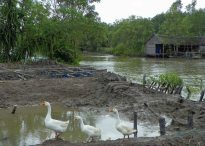
 A slow change in temperature and CO2 is not expected to negatively affect mangrove forests, however,0rapid changes combined with human activity and development could have a fatal impact on mangrove forests. As sea levels rise and saline water protrudes farther inland, mangroves are slowly migrating inward and towards areas densely populated by people. A key example is the mangrove forest in Can Gio that is slowly moving towards Ho Chi Minh City. It is highly implausible that HCMC would move to accommodate migrating mangroves. Furthermore, mangroves are likely to be impacted by other effects of climate change such as increased intensity and occurrence of storms and increased precipitation.
A slow change in temperature and CO2 is not expected to negatively affect mangrove forests, however,0rapid changes combined with human activity and development could have a fatal impact on mangrove forests. As sea levels rise and saline water protrudes farther inland, mangroves are slowly migrating inward and towards areas densely populated by people. A key example is the mangrove forest in Can Gio that is slowly moving towards Ho Chi Minh City. It is highly implausible that HCMC would move to accommodate migrating mangroves. Furthermore, mangroves are likely to be impacted by other effects of climate change such as increased intensity and occurrence of storms and increased precipitation.
Although the mangroves are threatened, domestic and international attention has helped them slowly bounce back. While they may never be restored to their natural grandeur due to human activity and the effects of climate change, efforts are being made to ensure their survival.
Of National Parks and International Issues
“Of National Parks and International Issues” by Justin Harkins
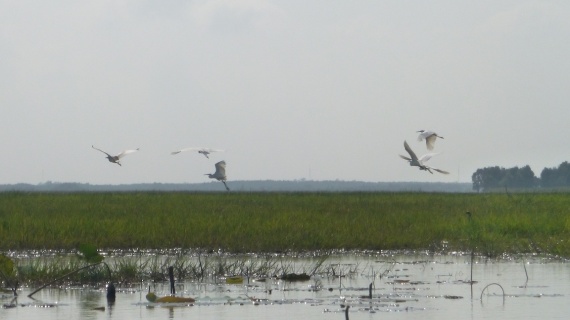 American documentarian Ken Burns recently dubbed the National Park system “America’s Best Idea” (full disclosure: I have not seen even one second of this documentary, but I was working at the now-shuttered Borders store in Bozeman when it was released on DVD), and we Montanans are proud and lucky that our state boasts, in Glacier and Yellowstone, two of the country’s premier national parks. Among my earliest memories are trips with my family to explore the trails, creeks, and mountain balds of Great Smoky Mountains N.P., and I remain an unreconstructed national park junkie. So it was with great anticipation and tremendous patience that I awaited the days we got to spend exploring some of the national parks in the Mekong Delta.
American documentarian Ken Burns recently dubbed the National Park system “America’s Best Idea” (full disclosure: I have not seen even one second of this documentary, but I was working at the now-shuttered Borders store in Bozeman when it was released on DVD), and we Montanans are proud and lucky that our state boasts, in Glacier and Yellowstone, two of the country’s premier national parks. Among my earliest memories are trips with my family to explore the trails, creeks, and mountain balds of Great Smoky Mountains N.P., and I remain an unreconstructed national park junkie. So it was with great anticipation and tremendous patience that I awaited the days we got to spend exploring some of the national parks in the Mekong Delta.
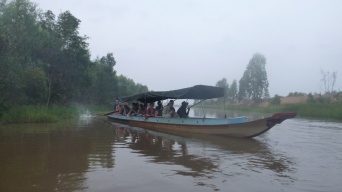 Vietnam’s first national park was established by Ho Chi Minh in 1962. Of the country’s burgeoning conservation movement, Ho said, “[t]he current destruction of our forests will lead to serious effects on climate, productivity, and life. The forest is gold. If we know how to conserve and manage it well, it will be very valuable.” Although Vietnam presently features 30 national parks and numerous other conservation areas, I would be gilding the lotus more than a little if I wrote that the country has been wholly successful in heeding Ho’s advice. Of course, were Vietnam alone in its imperfect environmental record, we likely would not be here to study climate change.
Vietnam’s first national park was established by Ho Chi Minh in 1962. Of the country’s burgeoning conservation movement, Ho said, “[t]he current destruction of our forests will lead to serious effects on climate, productivity, and life. The forest is gold. If we know how to conserve and manage it well, it will be very valuable.” Although Vietnam presently features 30 national parks and numerous other conservation areas, I would be gilding the lotus more than a little if I wrote that the country has been wholly successful in heeding Ho’s advice. Of course, were Vietnam alone in its imperfect environmental record, we likely would not be here to study climate change.  Anyway, for the purposes of this blog entry, it will suffice to say that Vietnam, like any country, has had to make certain choices that affect its ecosystems, and it hasn’t always chosen the course the environmentalists would prefer. Then again, sometimes it has, and we got to check out three vibrant examples of the country’s emergent conservation effort in the Mekong Delta.
Anyway, for the purposes of this blog entry, it will suffice to say that Vietnam, like any country, has had to make certain choices that affect its ecosystems, and it hasn’t always chosen the course the environmentalists would prefer. Then again, sometimes it has, and we got to check out three vibrant examples of the country’s emergent conservation effort in the Mekong Delta.
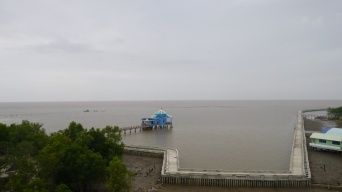 Our first national park experience was at the Mui Ca Mau N.P., which occupies 42,000 hectares on the very southern tip of Vietnam. The representative who spoke to us bragged that Mui Ca Mau is unique among Vietnam national parks for its level of biodiversity, and the Park represents something of an evolution in the Vietnamese conservation ethos as its borders extend far into the South China Sea.
Our first national park experience was at the Mui Ca Mau N.P., which occupies 42,000 hectares on the very southern tip of Vietnam. The representative who spoke to us bragged that Mui Ca Mau is unique among Vietnam national parks for its level of biodiversity, and the Park represents something of an evolution in the Vietnamese conservation ethos as its borders extend far into the South China Sea.  Where just 50 years ago Ho was extolling the future virtues of forest protection, the country is now devoting 27,000 hectares of national park real estate (and the money required to care for it) to land that exists entirely beneath the ocean. It represents a profoundly nuanced conception of the extent of its protection responsibility that
Where just 50 years ago Ho was extolling the future virtues of forest protection, the country is now devoting 27,000 hectares of national park real estate (and the money required to care for it) to land that exists entirely beneath the ocean. It represents a profoundly nuanced conception of the extent of its protection responsibility that  Vietnam has chosen to dedicate resources to protecting an area whose major ecosystem benefits are attenuated and slow to manifest; that’s precisely the sort of forbearance that characterizes a true commitment to conservation. As Michelle and I tip-toed across the bamboo boardwalk that led into Mui Ca Mau’s hauntingly beautiful mangrove forest, I gave silent thanks to our host country for rising to the challenge.
Vietnam has chosen to dedicate resources to protecting an area whose major ecosystem benefits are attenuated and slow to manifest; that’s precisely the sort of forbearance that characterizes a true commitment to conservation. As Michelle and I tip-toed across the bamboo boardwalk that led into Mui Ca Mau’s hauntingly beautiful mangrove forest, I gave silent thanks to our host country for rising to the challenge.
 The next stop on our park tour was the inland peat swamp at U Minh Thuong N.P. Recognized as one of the highest priority conservation sites in the Delta region, U Minh Thuong is a complex network of wetland ecosystems that provides an oasis for flora and fauna amid the countless rice paddies that checker the surrounding landscape. We explored the Park from the (relative) comfort of two long, slender speedboats while our guides drove us through plant-choked canals, and we enjoyed a lengthy stop at a remote observation tower where Dr. Viet, our accompanying instructor, taught us how the canal perfectly separates the dry Melaleuca forest on one side from the swampy wetland on the other.
The next stop on our park tour was the inland peat swamp at U Minh Thuong N.P. Recognized as one of the highest priority conservation sites in the Delta region, U Minh Thuong is a complex network of wetland ecosystems that provides an oasis for flora and fauna amid the countless rice paddies that checker the surrounding landscape. We explored the Park from the (relative) comfort of two long, slender speedboats while our guides drove us through plant-choked canals, and we enjoyed a lengthy stop at a remote observation tower where Dr. Viet, our accompanying instructor, taught us how the canal perfectly separates the dry Melaleuca forest on one side from the swampy wetland on the other.
We shared the canals that day with several local fishermen who comprised, along with a few farmers astride water buffaloes, the only non-staff people we encountered in any of the three parks. 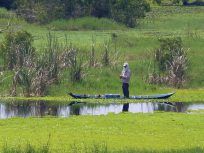 That solitude is a noticeable difference between the national park experiences in Vietnam and in the U.S., and it’s evidence of the different motivations that underlie each system. In the U.S., the National Parks are the country’s “crown jewels” to be preserved for the use and enjoyment of current and future generations.
That solitude is a noticeable difference between the national park experiences in Vietnam and in the U.S., and it’s evidence of the different motivations that underlie each system. In the U.S., the National Parks are the country’s “crown jewels” to be preserved for the use and enjoyment of current and future generations. 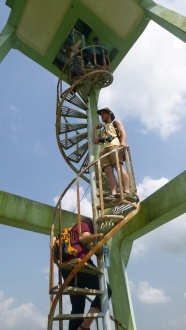 Conservation is certainly attendant to that preservation, but it’s not necessarily the primary goal (formally designated wilderness areas probably most completely fill that role at home); here, however, conservation is the avowed primary purpose of the national parks, and the instant sense of remoteness advertises the success of that mission.
Conservation is certainly attendant to that preservation, but it’s not necessarily the primary goal (formally designated wilderness areas probably most completely fill that role at home); here, however, conservation is the avowed primary purpose of the national parks, and the instant sense of remoteness advertises the success of that mission.
Our final stop was Tram Chim N.P. in Dông Thap province, to the northwest of where we had been previously.  Tram Chim is transected by the same sort of arterial canals as the two parks we visited before, and again we enjoyed a tour of the Park by boat. Tram Chim is at the center of an ancient topographical feature in Vietnam called the Plain of Reeds, whose wetland ecosystem once covered more than 700,000 hectares. Though the Plain has long since diminished in size, Tram Chim exists as a lush example of the staggering biodiversity that it once supported. Unfortunately, climate change threatens to further reduce the Plain’s vitality, even inside Tram Chim, as changing rain patterns and increasing heat disturb the native plants and, in turn, drive away the resident critters.
Tram Chim is transected by the same sort of arterial canals as the two parks we visited before, and again we enjoyed a tour of the Park by boat. Tram Chim is at the center of an ancient topographical feature in Vietnam called the Plain of Reeds, whose wetland ecosystem once covered more than 700,000 hectares. Though the Plain has long since diminished in size, Tram Chim exists as a lush example of the staggering biodiversity that it once supported. Unfortunately, climate change threatens to further reduce the Plain’s vitality, even inside Tram Chim, as changing rain patterns and increasing heat disturb the native plants and, in turn, drive away the resident critters.  We were lucky to spot three of the elusive and charismatic Sarus Cranes as they dined on their preferred Eleocharis tubers, yet Dr. Trang, our instructor at Tram Chim, lamented later that the Cranes will become rarer still as the increase in summer rain drowns the Eleocharis and prevents tuber production. Tram Chim was a sobering example that the act of embracing conservation as a mission, though a necessary and laudable step, is only just a step. Here’s hoping the Cranes will still be around when the rewards of that mission are finally realized. Until then, though, Vietnam should be proud of the hard work it has already done to preserve its remaining natural spaces, and I believe I can speak for the group when I say that we take special solace in the fact that America’s best idea has contributed to a healthier, more sustainable Vietnam.
We were lucky to spot three of the elusive and charismatic Sarus Cranes as they dined on their preferred Eleocharis tubers, yet Dr. Trang, our instructor at Tram Chim, lamented later that the Cranes will become rarer still as the increase in summer rain drowns the Eleocharis and prevents tuber production. Tram Chim was a sobering example that the act of embracing conservation as a mission, though a necessary and laudable step, is only just a step. Here’s hoping the Cranes will still be around when the rewards of that mission are finally realized. Until then, though, Vietnam should be proud of the hard work it has already done to preserve its remaining natural spaces, and I believe I can speak for the group when I say that we take special solace in the fact that America’s best idea has contributed to a healthier, more sustainable Vietnam.
Bye Bye Biodiversity
“Bye Bye Biodiversity” by Milo Anderson
By nature I am a very positive person, someone who is always trying to look at every situation optimistically. I need to be honest though, trying to be upbeat about Vietnam’s biodiversity, is not an easy task.
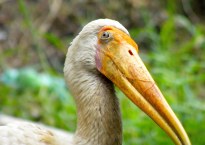 The state of Vietnam’s biodiversity is looking pretty darn bleak: high extinction rates, many threatened species, and sadly not a lot of effort taking place to change it. During our stay here in Vietnam we have been able to explore many parts of the Mekong Delta, but sadly we have seen more biodiversity on our restaurant menus then we have seen alive in the wild.
The state of Vietnam’s biodiversity is looking pretty darn bleak: high extinction rates, many threatened species, and sadly not a lot of effort taking place to change it. During our stay here in Vietnam we have been able to explore many parts of the Mekong Delta, but sadly we have seen more biodiversity on our restaurant menus then we have seen alive in the wild.  This comes as a huge surprise, since the Mekong River Basin is ranked number two in terms of diversity of both plants and animals out of the world’s river basins, only to be outnumbered by the famous Amazon River. Where has all that biodiversity gone? Has it moved upstream and out of Vietnam or has it simply disappeared?
This comes as a huge surprise, since the Mekong River Basin is ranked number two in terms of diversity of both plants and animals out of the world’s river basins, only to be outnumbered by the famous Amazon River. Where has all that biodiversity gone? Has it moved upstream and out of Vietnam or has it simply disappeared?
 Sadly the main cause of biodiversity decrease in the Mekong Delta is the international black market for wildlife where many Vietnamese wildlife species have been eradicated due to poaching practices. Species like civets, mynah birds, gibbons, and even bears are all commonly sold within this trade. The species affected by the market are limitless, since it is not just a concern in Vietnam, but rather it is a global issue reaching all continents.
Sadly the main cause of biodiversity decrease in the Mekong Delta is the international black market for wildlife where many Vietnamese wildlife species have been eradicated due to poaching practices. Species like civets, mynah birds, gibbons, and even bears are all commonly sold within this trade. The species affected by the market are limitless, since it is not just a concern in Vietnam, but rather it is a global issue reaching all continents.
In fact the present black market for wildlife is estimated to have a worth of anywhere from $5-10 billion annually; this shocking total is only dwarfed by the net worth of the trade of guns and drugs. It is difficult to believe that wildlife
 are being traded and used in a similar way as illegal drugs, and in many cases the demand is just as high if not higher for many of these animal products. With this level of demand for wildlife products like meat, skins, bile, bones, and scales; is there really any hope for Vietnamese wildlife?
are being traded and used in a similar way as illegal drugs, and in many cases the demand is just as high if not higher for many of these animal products. With this level of demand for wildlife products like meat, skins, bile, bones, and scales; is there really any hope for Vietnamese wildlife?
 Thankfully Vietnam is beginning to work towards restoring many of it vertebrate species though reintroduction programs across the country. Examples of some of these species are Siamese crocodiles and long-tailed macaques; hopefully some day in the future populations of these animals will be able to sustain themselves in the wild once more.
Thankfully Vietnam is beginning to work towards restoring many of it vertebrate species though reintroduction programs across the country. Examples of some of these species are Siamese crocodiles and long-tailed macaques; hopefully some day in the future populations of these animals will be able to sustain themselves in the wild once more.  On an even brighter note, within the past 20 years there have been over 60 new species of fauna discovered throughout the entire country of Vietnam. Many of these species are still considered extremely threatened but there is hope for saving them and improving the biodiversity of Vietnam. With these new discovers optimism is regained within the delta which sheds some much needed light on the all too bleak state of Vietnam’s natural places.
On an even brighter note, within the past 20 years there have been over 60 new species of fauna discovered throughout the entire country of Vietnam. Many of these species are still considered extremely threatened but there is hope for saving them and improving the biodiversity of Vietnam. With these new discovers optimism is regained within the delta which sheds some much needed light on the all too bleak state of Vietnam’s natural places.
 But what can we do, what actions can we take to make a difference towards improving Vietnam’s biodiversity? One of our professors at Can Tho University used this powerful statement during his conclusion; “the ending of understanding is the beginning of application.”
But what can we do, what actions can we take to make a difference towards improving Vietnam’s biodiversity? One of our professors at Can Tho University used this powerful statement during his conclusion; “the ending of understanding is the beginning of application.”  For example now that everyone in our group has greatly improved their understanding of the wildlife of Vietnam we can apply that in some way. We all have become warriors for wildlife whether we like to think we are or not. By simply sharing our memories from Vietnam all of us can take those memorable moments and turn them into opportunities to teach others. Just like that professor said understanding always comes before application, so now we must pass on the knowledge. In fact now that I think about it YOU (yes you) now have a better understanding of the biodiversity of Vietnam’s wildlife. So technically you can now pass on what you have learned too!
For example now that everyone in our group has greatly improved their understanding of the wildlife of Vietnam we can apply that in some way. We all have become warriors for wildlife whether we like to think we are or not. By simply sharing our memories from Vietnam all of us can take those memorable moments and turn them into opportunities to teach others. Just like that professor said understanding always comes before application, so now we must pass on the knowledge. In fact now that I think about it YOU (yes you) now have a better understanding of the biodiversity of Vietnam’s wildlife. So technically you can now pass on what you have learned too!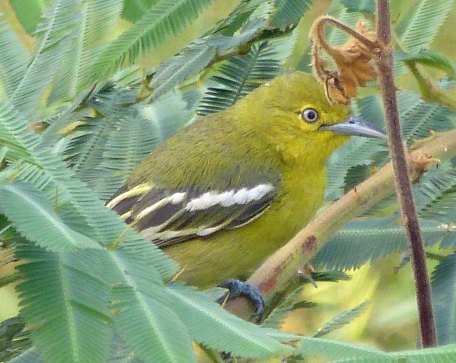
How are you going to make a difference for the wildlife of the Mekong Delta?
Not Exactly Buddhist
“Not Exactly Buddhist” by Harper Kaufman
One of our lecturers, Le Dinh Bich, wrote: “the table of culture stands on four legs:  material, social, mental, and spiritual.” As we dive into southern Vietnam hoping to absorb as much cultural understanding as possible, I find we do quite well with our material, social, and intellectual interactions. As a Religious Studies major, I an interested in developing the fourth, spiritual leg. To construct it, I intended to write on Buddhism in Vietnam, but I quickly discovered that Vietnamese spiritual beliefs are not as easily categorized or identified as I had hoped.
material, social, mental, and spiritual.” As we dive into southern Vietnam hoping to absorb as much cultural understanding as possible, I find we do quite well with our material, social, and intellectual interactions. As a Religious Studies major, I an interested in developing the fourth, spiritual leg. To construct it, I intended to write on Buddhism in Vietnam, but I quickly discovered that Vietnamese spiritual beliefs are not as easily categorized or identified as I had hoped.
 Historically, Vietnam has been a Buddhist country since the first or second century. With Chinese, Khmer, and Indian influences, manifestations of Buddhism in Vietnam are as multifaceted as the country’s history. The southern tradition, Theravada Buddhism and the northern sect, Mahayana Buddhism, can both be found fusing with Taoist and Confucianist influences.
Historically, Vietnam has been a Buddhist country since the first or second century. With Chinese, Khmer, and Indian influences, manifestations of Buddhism in Vietnam are as multifaceted as the country’s history. The southern tradition, Theravada Buddhism and the northern sect, Mahayana Buddhism, can both be found fusing with Taoist and Confucianist influences.  To complicate the picture further, 8% of the population subscribes to Catholicism since the missionaries introduced the faith in the 16th century. Islam, Judaism, and Hinduism each have small followings as well. Perhaps as a response to the multitude of traditions living under one roof, Vietnam created its own fascinating syncretic tradition. The result was Cao Daism: a fusion of Buddhism, Islam, Taoism, Christianity, Vietnamese spirituality, Confucianism, and even a dash of secular enlightenment to top it off.
To complicate the picture further, 8% of the population subscribes to Catholicism since the missionaries introduced the faith in the 16th century. Islam, Judaism, and Hinduism each have small followings as well. Perhaps as a response to the multitude of traditions living under one roof, Vietnam created its own fascinating syncretic tradition. The result was Cao Daism: a fusion of Buddhism, Islam, Taoism, Christianity, Vietnamese spirituality, Confucianism, and even a dash of secular enlightenment to top it off.
 I have observed that most religious practices in Vietnam have merged to some extent with other traditions. For example there is no one national prototype of pagoda (Buddhist temple). Instead you can see architectural and decorative styles that are as widely diverse as the religious influences on the country. I have been lucky enough to visit five separate pagodas, each as unique as the next. As a group we visited a Khmer temple and a monastery compound. At both, we were able to talk to monks in training who answered all of our questions until they had to excuse themselves to eat.
I have observed that most religious practices in Vietnam have merged to some extent with other traditions. For example there is no one national prototype of pagoda (Buddhist temple). Instead you can see architectural and decorative styles that are as widely diverse as the religious influences on the country. I have been lucky enough to visit five separate pagodas, each as unique as the next. As a group we visited a Khmer temple and a monastery compound. At both, we were able to talk to monks in training who answered all of our questions until they had to excuse themselves to eat.
 My host sister, Phuong Uyen, took Hailey and me to her family’s pagoda in Can Tho. The Chinese influence was immediately apparent. Chinese characters decorated the pillars, colorful Bonsai trees were painted on the windows, and I later read the whole building was designed to resemble the Chinese character for Nation.
My host sister, Phuong Uyen, took Hailey and me to her family’s pagoda in Can Tho. The Chinese influence was immediately apparent. Chinese characters decorated the pillars, colorful Bonsai trees were painted on the windows, and I later read the whole building was designed to resemble the Chinese character for Nation.  The central structure of the temple was a red faced, black bearded deity dressed in Blue imperial robes. I later learned this was Kuan-Kung Deity who symbolizes benevolence, civility, intellect and trustworthiness. When I asked Phuong Uyen about her family’s religious rituals, she responded that they “are not exactly Buddhist,” yet they visit this pagoda every full and new moon for traditional ceremonies as well as on Tet holiday (Vietnamese New Year).
The central structure of the temple was a red faced, black bearded deity dressed in Blue imperial robes. I later learned this was Kuan-Kung Deity who symbolizes benevolence, civility, intellect and trustworthiness. When I asked Phuong Uyen about her family’s religious rituals, she responded that they “are not exactly Buddhist,” yet they visit this pagoda every full and new moon for traditional ceremonies as well as on Tet holiday (Vietnamese New Year).
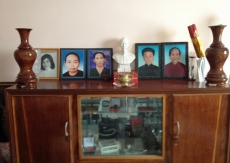 Her hesitation to identify as Buddhist was an allusion to her family’s deeper belief in Vietnamese ancestral worship, which dates back to a time before Buddhism or Confucianism. The women in Uyen’s family pray and offer incense daily to the ancestral altar standing in their home.
Her hesitation to identify as Buddhist was an allusion to her family’s deeper belief in Vietnamese ancestral worship, which dates back to a time before Buddhism or Confucianism. The women in Uyen’s family pray and offer incense daily to the ancestral altar standing in their home.  One of our TAs, Dua, told me altars (either dedicated to ancestors, the gods, or occasionally both) are typical of most Southern Vietnamese homes.
One of our TAs, Dua, told me altars (either dedicated to ancestors, the gods, or occasionally both) are typical of most Southern Vietnamese homes.
As I had hoped, there are many ways the religious traditions of Vietnam can lend themselves to the country’s necessary response to climate change effects. In every pagoda one is asked to take shoes off before entering. It is this type of respect and cleanliness that people must apply to our earth. 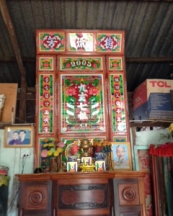 When Dua performed a ritual, which disclosed her fortune for the year, she told me it was not good, but she will just need to be careful. With the gloomy predictions climate scientist have for Vietnam, it is this attitude of hopeful caution with which the country must preceed. As we were kindly explained the story of the Buddha’s life at the Bat Pagoda in Soc Trang, I was reminded enlightenment came as Buddha discovered the middle path. Just as Buddha balanced the lifestyles of asceticism and indulgence, Vietnam must learn how to combine growth and prosperity with sustainability and environmental protection. And finally, just as Vietnam has learned to harmonize spiritual beliefs from around the globe into its own unique blend, I hope Vietnam finds a way to embrace adaptation techniques and mitigation efforts without sacrificing its rich and beautiful culture.
When Dua performed a ritual, which disclosed her fortune for the year, she told me it was not good, but she will just need to be careful. With the gloomy predictions climate scientist have for Vietnam, it is this attitude of hopeful caution with which the country must preceed. As we were kindly explained the story of the Buddha’s life at the Bat Pagoda in Soc Trang, I was reminded enlightenment came as Buddha discovered the middle path. Just as Buddha balanced the lifestyles of asceticism and indulgence, Vietnam must learn how to combine growth and prosperity with sustainability and environmental protection. And finally, just as Vietnam has learned to harmonize spiritual beliefs from around the globe into its own unique blend, I hope Vietnam finds a way to embrace adaptation techniques and mitigation efforts without sacrificing its rich and beautiful culture.
Fly Fishing as an Ecotourism Model for the Mekong River Delta: Sustainable or Insane?
Fly Fishing as an Ecotourism Model for the Mekong River Delta: Sustainable or Insane? By Ada Montague
 Ecotourism is a form of travel that seeks to improve environmental awareness, foster cultural respect, and benefit the economic development of local communities. When done properly it can protect fragile ecosystems while providing a high quality tourism experience that generates revenue with minimal negative impacts to the environment.
Ecotourism is a form of travel that seeks to improve environmental awareness, foster cultural respect, and benefit the economic development of local communities. When done properly it can protect fragile ecosystems while providing a high quality tourism experience that generates revenue with minimal negative impacts to the environment.
 The Mekong Delta is something like a mecca for fishing in Vietnam, with one of the world’s largest and most productive inland fisheries. The Delta is responsible for 70% of Vietnam’s annual fish production. However, threats from sea level rise, climate change, overfishing and pollution increasingly imperil fish species as well as critical habitat areas. (Read More Here) Part of the problem is a lack of funding. In order to clean up the Delta, protect threatened species, and increase its overall value in the eyes of the world new reliable sources of revenue are necessary.
The Mekong Delta is something like a mecca for fishing in Vietnam, with one of the world’s largest and most productive inland fisheries. The Delta is responsible for 70% of Vietnam’s annual fish production. However, threats from sea level rise, climate change, overfishing and pollution increasingly imperil fish species as well as critical habitat areas. (Read More Here) Part of the problem is a lack of funding. In order to clean up the Delta, protect threatened species, and increase its overall value in the eyes of the world new reliable sources of revenue are necessary.
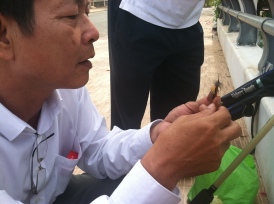 Fly fishing is an ancient sport, dating back to the end of the 2nd Century in Rome. The sport has slowly moved across the globe to become popular in many areas. It is something like a religion in Montana alone. The art of tying flies from bits of fur and feathers to create life-like fake bait distinguishes this form of fishing from other live bait styles. It is also known for its conservation ethic of “catch-and-release,” which is used to prevent target species from disappearing from a particular river. Furthermore, fly fishing is big business. In 2012, fly fishing shops around the United States generated $748.6 million in sales, according to the American Fly Fishing Trade Association.
Fly fishing is an ancient sport, dating back to the end of the 2nd Century in Rome. The sport has slowly moved across the globe to become popular in many areas. It is something like a religion in Montana alone. The art of tying flies from bits of fur and feathers to create life-like fake bait distinguishes this form of fishing from other live bait styles. It is also known for its conservation ethic of “catch-and-release,” which is used to prevent target species from disappearing from a particular river. Furthermore, fly fishing is big business. In 2012, fly fishing shops around the United States generated $748.6 million in sales, according to the American Fly Fishing Trade Association.
Could fly fishing be a potential ecotourism model for the Mekong River Delta?
PROS
- The Mekong Delta is an extraordinary place that attracts international tourism. It is considered one of the must-see places of the world, boasting many cultural and natural attractions.
- The Mekong Delta has a long history of boat-based travel. The design of these boats is ideal for fishing the Mekong’s waters and lends itself well to fly fishing.

- The Mekong Delta is known for is wide array of fish species. Many of these fish species are subject to overfishing and habitat loss and need protection.
- Certain species of fish, such as snake head and the Asian Awrana, may attract sport fishing.
Snakehead:
Asian Awrana:
(source: http://www.flickriver.com/photos/48814374@N00/6764631761/)
- “Pleasure fishing” at Minh Thuong National Park generates 30% of the park’s funding (anglers bring in ~$250/day for the park), allowing further research and conservation efforts to be completed.
- Fly Fishing as an ecotourism model has already been a success in Thailand and Cambodia, where fishermen are paid not to overfish particular bodies of water. In addition, visiting sport fishermen pay a rod fee. (Read More Here)

CONS
- The Mekong Delta is a silted water body situated at the mouth of the Mekong River as it exits into the South China Sea. With low visibility, anglers may find these waters difficult to fish.
- Poor water quality and sanitation in general may deter fly fishermen used to pristine mountain streams.
- There are limited “sport fish” to catch in the Delta, with the majority of large fish being catfish or other bottom feeding species. A majority of the aquatic species include a large variety of life forms other than fish.
In conclusion, the biodiversity of the Mekong Delta is at risk. Sea level rise and climate change may top the list, but overfishing, pollution, upstream dams, and a lack of funding all rank a close second. Fly fishing or other forms of sustainable recreational fishing may provide a reliable alternative funding source that meets the dual goals of ecotourism: generate revenue while treading lightly on a threatened ecosystem. Furthermore, exploring such an option does not appear to be very difficult due to the already boat-based, fishing culture of the Delta. From a preliminary glance, the concept of fly fishing as an ecotourism model appears to be at least an option worth further exploring.
Water Management and a Changing Climate: Issues and Adaptation
“Water Management and a Changing Climate: Issues and Adaptation” by Milan Vinks
 Water is arguably the most important resource on our planet. Without this substance and the unique characteristics associated with it life as we know it would not exist. Here in Vietnam and the Mekong River delta region, water is particularly important to the rural population, the majority of whom rely on rice farming and freshwater aquaculture for their subsistence. Besides sustaining a way of life, water in the Mekong delta is also crucial to Vietnam’s food production and export earnings. Rice production in the Mekong River delta accounts for 50% of Vietnam’s total rice production and accounts for 90% of the country’s rice export. Management of water resources in the Mekong Delta is thus essential in sustaining the livelihoods of the majority of the region’s population and assuring economic stability in the future.
Water is arguably the most important resource on our planet. Without this substance and the unique characteristics associated with it life as we know it would not exist. Here in Vietnam and the Mekong River delta region, water is particularly important to the rural population, the majority of whom rely on rice farming and freshwater aquaculture for their subsistence. Besides sustaining a way of life, water in the Mekong delta is also crucial to Vietnam’s food production and export earnings. Rice production in the Mekong River delta accounts for 50% of Vietnam’s total rice production and accounts for 90% of the country’s rice export. Management of water resources in the Mekong Delta is thus essential in sustaining the livelihoods of the majority of the region’s population and assuring economic stability in the future.
 The main source of water for the Mekong River delta region is the Mekong River, which is one of the few great, largely unregulated rivers in the world. This river originates in the high Tibetan Plataea and meanders through China, Burma, Laos, Thailand, Cambodia and Vietnam, where it releases about 475 km3 each year into the “South China Sea”. In 1995 Laos, Thailand, Cambodia, and Vietnam established the Mekong River Commission in order to manage and coordinate utilization of the river’s resources on an international level. However, on top of the international management of these water resources, each country faces unique management challenges once they have received the water, particularly Vietnam.
The main source of water for the Mekong River delta region is the Mekong River, which is one of the few great, largely unregulated rivers in the world. This river originates in the high Tibetan Plataea and meanders through China, Burma, Laos, Thailand, Cambodia and Vietnam, where it releases about 475 km3 each year into the “South China Sea”. In 1995 Laos, Thailand, Cambodia, and Vietnam established the Mekong River Commission in order to manage and coordinate utilization of the river’s resources on an international level. However, on top of the international management of these water resources, each country faces unique management challenges once they have received the water, particularly Vietnam.
Since we have spent most of our time in the Mekong River delta region of Vietnam, I will specifically touch on the unique water-land issues that this region faces. These issues exist because of the region’s particular geomorphology and sedimentary composition. 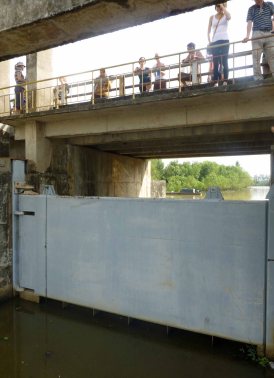
 These aspects lead to problems such as acute flooding in the wet season; acid sulfate soils constraints on crop productivity in over 40% of the lower Delta and associated, severe, acidic drainage waters with major implications for aquatic productivity; seawater intrusion in the dry season in the lower Delta, limiting rice production to one crop per year in saline intrusion areas; and impacts of seawater intrusion floodgates on acidification (White, 2002). In order to manage these problems the Mekong River delta has become a network of canals, dikes, and sluice gates.
These aspects lead to problems such as acute flooding in the wet season; acid sulfate soils constraints on crop productivity in over 40% of the lower Delta and associated, severe, acidic drainage waters with major implications for aquatic productivity; seawater intrusion in the dry season in the lower Delta, limiting rice production to one crop per year in saline intrusion areas; and impacts of seawater intrusion floodgates on acidification (White, 2002). In order to manage these problems the Mekong River delta has become a network of canals, dikes, and sluice gates. 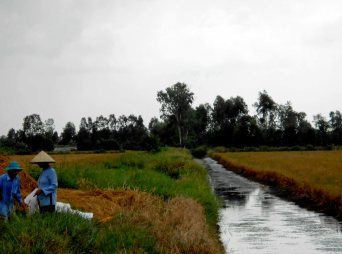 These infrastructural components assure that freshwater can be readily transported throughout the region, they allow excess floodwater and drainage water to be evacuated, and they provide a means of controlling preferred salinity levels based on the season. However, with an annual sea level rise of 2.8 mm and an increased risk of severe droughts, Vietnam has to actively pursue new strategies to mitigate and adapt to the impending impacts of climate change.
These infrastructural components assure that freshwater can be readily transported throughout the region, they allow excess floodwater and drainage water to be evacuated, and they provide a means of controlling preferred salinity levels based on the season. However, with an annual sea level rise of 2.8 mm and an increased risk of severe droughts, Vietnam has to actively pursue new strategies to mitigate and adapt to the impending impacts of climate change.
 Fortunately, many Vietnamese researchers and politicians realize the potential implications associated with climate change and are actively sponsoring new sustainable methods to cope with these challenges. A key focus area is promoting more sustainable farming practices to preserve precious freshwater resources, especially in agricultural regions nearer to the coast,
Fortunately, many Vietnamese researchers and politicians realize the potential implications associated with climate change and are actively sponsoring new sustainable methods to cope with these challenges. A key focus area is promoting more sustainable farming practices to preserve precious freshwater resources, especially in agricultural regions nearer to the coast, 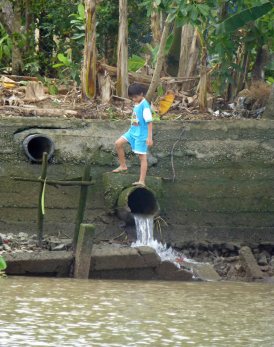 where saline intrusion is a serious threat, and in regions that are already more susceptible to droughts. Such practices include integrated farming systems near coastal areas that grow paddy rice during the rainy season, when freshwater is readily available, and switch over to shrimp farming in the dry season when saline intrusion favors saltwater aquaculture.
where saline intrusion is a serious threat, and in regions that are already more susceptible to droughts. Such practices include integrated farming systems near coastal areas that grow paddy rice during the rainy season, when freshwater is readily available, and switch over to shrimp farming in the dry season when saline intrusion favors saltwater aquaculture.  In areas where droughts are already prominent, integrated rice and fish farming is recommended, where fishponds function as reservoirs, supplying rice crops with water in the case of drought. Hopefully these strategies will establish sustainable water management, while simultaneously preserving the livelihoods of farmers in the Mekong River delta and assuring the stability of Vietnam’s agricultural Economy in the future.
In areas where droughts are already prominent, integrated rice and fish farming is recommended, where fishponds function as reservoirs, supplying rice crops with water in the case of drought. Hopefully these strategies will establish sustainable water management, while simultaneously preserving the livelihoods of farmers in the Mekong River delta and assuring the stability of Vietnam’s agricultural Economy in the future.
References
White, Ian. 2002. Water Management in the Mekong Delta: Changes, Conflicts and Opportunities. Technical Documents in Hydrology No. 61.
Dr. Duong Van Ni. The Mekong Delta of Vietnam: Development and Environment
Dr. Nguyễn Hiếu Trung. Climate Change and Sea Level Rise impacts and adaptations in the Mekong Delta.
Pham Le Thong. An Overview of the Vietnam and Mekong Delta’s Economy.
Floating Through Traditions
“Floating Through Traditions” by Michelle Harkins
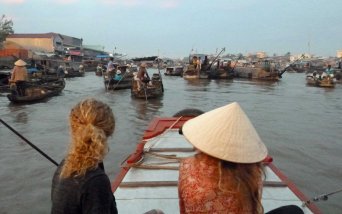 The alarm went off at 4:00 in the morning, which is early for anyone, but that’s the time you have to rise when you want to experience the floating market in Can Tho, Vietnam. We loaded a boat when it was still dark outside and set off down the river.
The alarm went off at 4:00 in the morning, which is early for anyone, but that’s the time you have to rise when you want to experience the floating market in Can Tho, Vietnam. We loaded a boat when it was still dark outside and set off down the river.
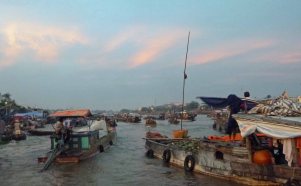 The pre-dawn light gave us just enough perspective to see the market from a distance as we floated toward it, and at first it didn’t look like much – just a bunch of boats gathered together.
The pre-dawn light gave us just enough perspective to see the market from a distance as we floated toward it, and at first it didn’t look like much – just a bunch of boats gathered together.  A small boat, serving market-goers and tourists, sold us coffee, water, and soft drinks just as the sun was rising, and we motored toward the market under the soft light of a tropical morning with fresh drinks in our hands. As we approached the market, the river became a maze of countless boats packed with local fruits, vegetables, and other crops.
A small boat, serving market-goers and tourists, sold us coffee, water, and soft drinks just as the sun was rising, and we motored toward the market under the soft light of a tropical morning with fresh drinks in our hands. As we approached the market, the river became a maze of countless boats packed with local fruits, vegetables, and other crops.
 The process is as follows: between 12:00 and 2:00 A.M., the farmers who actually grow the produce gather to sell their goods to the people who work on the boats that comprise the floating market. Around 3:00, the boat workers all congregate in one area on the river to resell the goods they have just bought to people who work in local markets around town. From 4:00 until around 9:00 (with most of the action complete by 7:00) the floating market is buzzing with commerce between the wholesale-level floating market workers and the retail-level land market workers.
The process is as follows: between 12:00 and 2:00 A.M., the farmers who actually grow the produce gather to sell their goods to the people who work on the boats that comprise the floating market. Around 3:00, the boat workers all congregate in one area on the river to resell the goods they have just bought to people who work in local markets around town. From 4:00 until around 9:00 (with most of the action complete by 7:00) the floating market is buzzing with commerce between the wholesale-level floating market workers and the retail-level land market workers.
 The sellers at the market advertise what they have on their boats by hanging a sample on the top of a long post, called a “promotional pole.” That way, buyers have the ability to see from a distance what is available for purchase on each boat and choose what they want and where to buy. The amount and variety of items on the boats was incredible, including some items that either are not available or are very rare in grocery stores in the US.
The sellers at the market advertise what they have on their boats by hanging a sample on the top of a long post, called a “promotional pole.” That way, buyers have the ability to see from a distance what is available for purchase on each boat and choose what they want and where to buy. The amount and variety of items on the boats was incredible, including some items that either are not available or are very rare in grocery stores in the US.
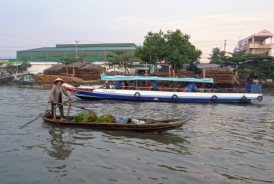 After the rush is finished in the river outside Can Tho, some of the boats continue to float down the river and sell what goods they have remaining to other communities. Historically, canals are the easiest method of transportation in the Mekong Delta, and the waterways are still heavily used today. Floating markets traditionally acted as trading channels between communities, and even as cars and motorbikes (and, increasingly in Vietnam, planes and cargo liners) have provided different means for potential sales and trade, the floating market remains a heavily used model.
After the rush is finished in the river outside Can Tho, some of the boats continue to float down the river and sell what goods they have remaining to other communities. Historically, canals are the easiest method of transportation in the Mekong Delta, and the waterways are still heavily used today. Floating markets traditionally acted as trading channels between communities, and even as cars and motorbikes (and, increasingly in Vietnam, planes and cargo liners) have provided different means for potential sales and trade, the floating market remains a heavily used model.
 One aspect of the floating market that I found very interesting is that, while some people use their boats solely for the purpose of selling goods, there are also houseboats that serve as both floating market storefronts and family homes. Several generations can live and work on these houseboats. When the children grow up, it is very common for them to work on the family’s boat or another boat to save money until they have enough to buy their own boat to start a business. A boat in Vietnam can be bought for around 50,000,000 Vietnamese dong or roughly 2,500 U.S. dollars.
One aspect of the floating market that I found very interesting is that, while some people use their boats solely for the purpose of selling goods, there are also houseboats that serve as both floating market storefronts and family homes. Several generations can live and work on these houseboats. When the children grow up, it is very common for them to work on the family’s boat or another boat to save money until they have enough to buy their own boat to start a business. A boat in Vietnam can be bought for around 50,000,000 Vietnamese dong or roughly 2,500 U.S. dollars.
 The floating market process, while initially appearing very foreign to me, actually has a lot in common with retail systems in the U.S. People make or grow goods, which they then sell to a middle man, who either sells the product to the consumer or sells it to a store. While the two may have a similar structure, the experience itself was very different. By visiting this cultural site, we had the opportunity the view a tradition that has been with Vietnam for centuries and that still strongly works for this region. I found it interesting that we had the opportunity to see a form of commerce that has been going on for centuries relatively unchanged at its core, even while it has changed a great deal in the sense that you are now seeing boats powered by engines and motors buzzing around, instead of being rowed by people. In a way, the floating market is representative of Vietnam as a whole, because the country is often in the same sort of tension between holding onto its past traditions but also modernizing. The market was so interesting largely because it preserves the cultural essence of historic Vietnam but exists as a motoring example of how new technology can be added to old scenes.
The floating market process, while initially appearing very foreign to me, actually has a lot in common with retail systems in the U.S. People make or grow goods, which they then sell to a middle man, who either sells the product to the consumer or sells it to a store. While the two may have a similar structure, the experience itself was very different. By visiting this cultural site, we had the opportunity the view a tradition that has been with Vietnam for centuries and that still strongly works for this region. I found it interesting that we had the opportunity to see a form of commerce that has been going on for centuries relatively unchanged at its core, even while it has changed a great deal in the sense that you are now seeing boats powered by engines and motors buzzing around, instead of being rowed by people. In a way, the floating market is representative of Vietnam as a whole, because the country is often in the same sort of tension between holding onto its past traditions but also modernizing. The market was so interesting largely because it preserves the cultural essence of historic Vietnam but exists as a motoring example of how new technology can be added to old scenes.
Aquaculture and Fisheries in the Mekong Delta
“Aquaculture and Fisheries in the Mekong Delta” by Rennie Winkelman
There are over two hundred bones in the human body, but none are as important as the backbone. Your backbone provides support for the rest of your body and protection for your livelihood.  Agriculture and aquaculture make up the backbone of Vietnam. They provide economic security and support and are an integral part of the country’s culture. As sea level rise and saltwater intrusion into farmlands become more prolific, agriculture is being threatened, jeopardizing the livelihood of the entire country.
Agriculture and aquaculture make up the backbone of Vietnam. They provide economic security and support and are an integral part of the country’s culture. As sea level rise and saltwater intrusion into farmlands become more prolific, agriculture is being threatened, jeopardizing the livelihood of the entire country.  Therefore, the Vietnamese are turning to aquaculture as a way to subsidize their incomes. The amount of shrimp farming has increased throughout the nation, and shrimp has become Vietnam’s fourth most valuable export.
Therefore, the Vietnamese are turning to aquaculture as a way to subsidize their incomes. The amount of shrimp farming has increased throughout the nation, and shrimp has become Vietnam’s fourth most valuable export.
Intensive shrimp farming, however, can be harmful to the environment. Farmers have to use chemicals to maintain water quality and clear large swaths of land for shrimp ponds. This high intensity, artificial style of farming produces a lot more product for the market, but the government has placed limits on the number of farmers who can use this high yield method. More natural, integrated systems of shrimp farming are much more sustainable.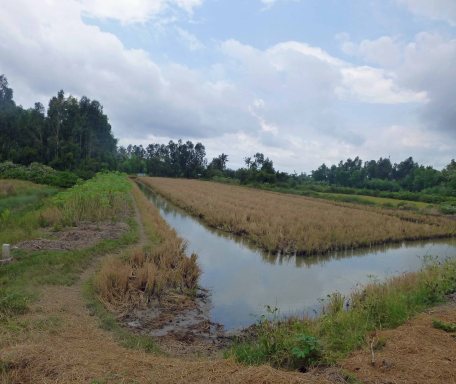
 Most shrimp farmers use a lower yield, integrated system with rice paddies or mangrove forests. We visited two different farmers who use an integrated mangrove-shrimp farming system. They use a system of dikes, water gates, and nets, coordinated with the lunar cycle. At high tide they let brackish water in through the gates, and juvenile shrimp swim into the mangrove pond.
Most shrimp farmers use a lower yield, integrated system with rice paddies or mangrove forests. We visited two different farmers who use an integrated mangrove-shrimp farming system. They use a system of dikes, water gates, and nets, coordinated with the lunar cycle. At high tide they let brackish water in through the gates, and juvenile shrimp swim into the mangrove pond.  The shrimp mature in the mangroves. At low tide the farmers open the gates and the water rushes back out towards the ocean. The mature shrimp are attracted to the higher salinity so they swim out through the gates and into the nets. The juvenile shrimp in the mangroves prefer the less saline environment so they do not swim out into the nets until they are mature enough to sell at the market. This repeats every two weeks as the lunar cycle hits the full moon and new moon.
The shrimp mature in the mangroves. At low tide the farmers open the gates and the water rushes back out towards the ocean. The mature shrimp are attracted to the higher salinity so they swim out through the gates and into the nets. The juvenile shrimp in the mangroves prefer the less saline environment so they do not swim out into the nets until they are mature enough to sell at the market. This repeats every two weeks as the lunar cycle hits the full moon and new moon.  It is a very effective system; the first farmer we visited said that he could make up to ten million Vietnamese dong each day in the market. In the integrated rice-shrimp system they raise rice in the rainy season when there is fresh water in the fields and raise shrimp in the dry season when they open the dikes and allow salt water in. Most farmers can raise one rice crop and two shrimp harvests in one year.
It is a very effective system; the first farmer we visited said that he could make up to ten million Vietnamese dong each day in the market. In the integrated rice-shrimp system they raise rice in the rainy season when there is fresh water in the fields and raise shrimp in the dry season when they open the dikes and allow salt water in. Most farmers can raise one rice crop and two shrimp harvests in one year.
 These more sustainable methods are much better for the environment, and they are still an economically viable way to support a family. As the climate continues to change, it is important to educate farmers about methods like these integrated farming systems, so they can adapt to new problems that arise and not contribute much to those problems themselves.
These more sustainable methods are much better for the environment, and they are still an economically viable way to support a family. As the climate continues to change, it is important to educate farmers about methods like these integrated farming systems, so they can adapt to new problems that arise and not contribute much to those problems themselves. 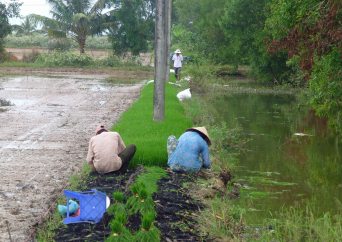 Sea level and saltwater intrusion are still increasing, and if farmers do not know about the problems or how to adapt they may lose their way of living or make the environment worse than it already is. Integrated aquaculture strategies give farmers a low risk, more sustainable way to increase their income, as well as being better for the natural environment. It is a win-win situation.
Sea level and saltwater intrusion are still increasing, and if farmers do not know about the problems or how to adapt they may lose their way of living or make the environment worse than it already is. Integrated aquaculture strategies give farmers a low risk, more sustainable way to increase their income, as well as being better for the natural environment. It is a win-win situation.
Pointing Things Out
Pointing Things Out by Ben Simonson
Anyone arriving to their hotel room after a 24 hour plane ride from the United States to Vietnam would want to shower, change clothes, and brush their teeth. Unfortunately, I could not do most of the above because my luggage was delayed in transit. Two days later, our contact at the University of Can Tho told me she had found my bag and that it would arrive in one day. The thought that I would never see my precious belongings immediately left and was replaced with a feeling of pure joy that manifested into a pointed finger aimed directly at her face followed by an ecstatic shout of thank you. In the U.S., this gesture would likely be reciprocated with a high five, or a feeling of satisfaction from the recipient of the point. Instead of a high five, the reaction was a shocked, backwards movement similar to a jump, as if to dodge a slap. It all happened very quickly. Through further investigation I learned that it is rude to deliberately point at someone above the chest. Even if your feelings and motivations for pointing are positive. To ensure a cultural miscommunication like this didn’t happen again, I asked around and did some research on what not to do. Very fascinating indeed.
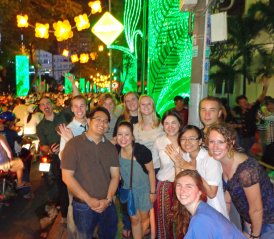 On New Year’s Eve, we went into the heart of Ho Chi Minh City to watch the ball drop. The streets were packed shoulder to shoulder with young Vietnamese who were similarly looking to have a good time. How we were treated, though, was truly amazing in how it was as if we had walked off the red carpet.
On New Year’s Eve, we went into the heart of Ho Chi Minh City to watch the ball drop. The streets were packed shoulder to shoulder with young Vietnamese who were similarly looking to have a good time. How we were treated, though, was truly amazing in how it was as if we had walked off the red carpet.  People made an effort to give us high fives and say “Chúc mừng năm mới,” which translates to “Happy New Year!” The hospitality didn’t stop there either. In Ca Mau, which is a small city of roughly 700,000 people near the Southern point of Vietnam people were simply amazed to see us. One night, while walking around Ca Mau, we were invited to a wedding reception.
People made an effort to give us high fives and say “Chúc mừng năm mới,” which translates to “Happy New Year!” The hospitality didn’t stop there either. In Ca Mau, which is a small city of roughly 700,000 people near the Southern point of Vietnam people were simply amazed to see us. One night, while walking around Ca Mau, we were invited to a wedding reception.  They were ecstatic to say the least as they fed us drinks and gave us hugs. Why the Vietnamese treat us the way we do, especially in the relatively recent aftermath of the American war is what I am surprised about. I asked this question to my host dad who quickly dismissed the question by saying “we forget about it.” That statement spoke a thousand words, and I took it as advice, but was not completely satisfied. Likely, it is the social philosophy of “face” that directs the Vietnamese culture into such humble interactions, and likely, I will never really understand it.
They were ecstatic to say the least as they fed us drinks and gave us hugs. Why the Vietnamese treat us the way we do, especially in the relatively recent aftermath of the American war is what I am surprised about. I asked this question to my host dad who quickly dismissed the question by saying “we forget about it.” That statement spoke a thousand words, and I took it as advice, but was not completely satisfied. Likely, it is the social philosophy of “face” that directs the Vietnamese culture into such humble interactions, and likely, I will never really understand it.
The concept of face is held in high regard in Vietnamese custom. Face refers to how you come across to others. Ideally, you want to carry a “big face,” while at the same time avoid taking face from others.  Face is taken by getting angry at someone or shaming someone. It can be described as the tail between the legs or the cold shoulder feeling as we call it in the U.S., and should be avoided at all costs. The Vietnamese are very nice people, likely because of how the concept of face governs interactions between each other.
Face is taken by getting angry at someone or shaming someone. It can be described as the tail between the legs or the cold shoulder feeling as we call it in the U.S., and should be avoided at all costs. The Vietnamese are very nice people, likely because of how the concept of face governs interactions between each other. 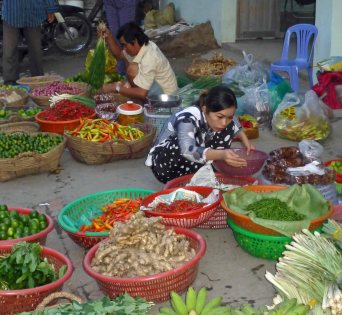 Throughout my experience in Vietnam, I have yet to witness any animosity towards each other, even in the market, where many vendors sell the exact same piece of fruit within 20 meters of one another. The Vietnamese people are some of the nicest people I have experienced, and I attribute their collective kindness to the concept of face as a social philosophy.
Throughout my experience in Vietnam, I have yet to witness any animosity towards each other, even in the market, where many vendors sell the exact same piece of fruit within 20 meters of one another. The Vietnamese people are some of the nicest people I have experienced, and I attribute their collective kindness to the concept of face as a social philosophy.
The Vietnamese family is the primary social unit, and the differences between the Vietnamese family and the American family are distinct. In the U.S., the parents raise the children, the children leave the parent’s household, marry, and have children of their own.  In Vietnam, it is very common to see three generations living under the same roof with the husband being the head of the household. The duty of the grandparents is to educate the children while the parents make money to support the children and grandparents. During the home stay, the head of the household’s father was the only grandparent present. He spoke no English, but the strong relationship to their only daughter was apparent. This way of organizing the family is strange to me, but I could see how it would be a healthy way to raise children; constant input from two generations.
In Vietnam, it is very common to see three generations living under the same roof with the husband being the head of the household. The duty of the grandparents is to educate the children while the parents make money to support the children and grandparents. During the home stay, the head of the household’s father was the only grandparent present. He spoke no English, but the strong relationship to their only daughter was apparent. This way of organizing the family is strange to me, but I could see how it would be a healthy way to raise children; constant input from two generations.
 Throughout my 12 days here so far, Vietnam has proven to be a culturally charged country. Coming from the U.S. causes quite a culture shock, but the initial feeling of offense is soon muffled by the benevolent nature of the Vietnamese.
Throughout my 12 days here so far, Vietnam has proven to be a culturally charged country. Coming from the U.S. causes quite a culture shock, but the initial feeling of offense is soon muffled by the benevolent nature of the Vietnamese.
Responding to Climate Change in the Mekong Delta
Responding to Climate Change in the Mekong Delta by Rebecca Singleton
 Climate change is a reality for the Mekong delta. The Mekong River Delta is the perhaps the most vulnerable delta for climate change in the world. Year round this region faces problems like flooding during the rainy season, saline intrusion from the East Sea, sea level rise (SLR), and increasingly harsh storms and typhoons. Because people living in the Mekong Delta are already starting to see the changes that climate change bring, a growing concern for climate change and adaptation is present.
Climate change is a reality for the Mekong delta. The Mekong River Delta is the perhaps the most vulnerable delta for climate change in the world. Year round this region faces problems like flooding during the rainy season, saline intrusion from the East Sea, sea level rise (SLR), and increasingly harsh storms and typhoons. Because people living in the Mekong Delta are already starting to see the changes that climate change bring, a growing concern for climate change and adaptation is present.
 Climate change for Vietnam means increased heat waves, droughts, strong typhoons, major rainstorms and SLR. The effects of climate change can be seen all over Vietnam with decreasing rainfall in the north and increasing rainfall in the south.
Climate change for Vietnam means increased heat waves, droughts, strong typhoons, major rainstorms and SLR. The effects of climate change can be seen all over Vietnam with decreasing rainfall in the north and increasing rainfall in the south.  Already over the past 50 year the annual average temperature of Vietnam has increased by .5 degrees Celsius. Most of the local people here do not know the science of climate change; they just know that things are changing and they must adapt or leave. The East Sea, for example, has experienced SLR of 4.7 mm per year from 1993-2004. A 2.9 mm/year rise has also occurred along the costal area of Vietnam.
Already over the past 50 year the annual average temperature of Vietnam has increased by .5 degrees Celsius. Most of the local people here do not know the science of climate change; they just know that things are changing and they must adapt or leave. The East Sea, for example, has experienced SLR of 4.7 mm per year from 1993-2004. A 2.9 mm/year rise has also occurred along the costal area of Vietnam.
SLR is caused by ocean warming and increasing greenhouse gas emissions. This is such a big problem in the Mekong Delta because it will add to the already intense flooding the area faces during the rainy season. About 70% of the Mekong Delta is predicted to be flooded annually thus threatening the agriculture that most people in this area rely on. In addition to the problems it will bring to agriculture SLR will also pose problems for things like building construction and transportation infrastructure. But perhaps most importantly SLR will cause salinity intrusion.
Salinity intrusion is very dangerous to the region because it will affect the rice crops that so many people living here depend on. 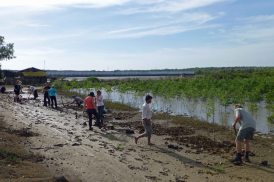 This has become such a big problem that the government has put in place salinity control systems. These control systems are a network of dikes and gates that drain water in the flood season. These gates are closed in the dry season and open in the wet season at the second rice harvest. This is because during the dry season there is less upstream flow there is an increase in saline intrusion. These gates and dykes are close during this time to prevent a flux of salinity in the dry season.
This has become such a big problem that the government has put in place salinity control systems. These control systems are a network of dikes and gates that drain water in the flood season. These gates are closed in the dry season and open in the wet season at the second rice harvest. This is because during the dry season there is less upstream flow there is an increase in saline intrusion. These gates and dykes are close during this time to prevent a flux of salinity in the dry season.
 Several farmers in the delta have begun experimenting with different rice varieties to find one that is more tolerant to submersion and salinity. They have also been experimenting with shifting the cropping calendar and switching to different crops. Some tolerant varieties of rice have been used but farmers are reluctant to use them because they take longer to grow and the quality is not as good. As salinity becomes more of a problem some farmers are beginning to think about switching over to farming shrimp.
Several farmers in the delta have begun experimenting with different rice varieties to find one that is more tolerant to submersion and salinity. They have also been experimenting with shifting the cropping calendar and switching to different crops. Some tolerant varieties of rice have been used but farmers are reluctant to use them because they take longer to grow and the quality is not as good. As salinity becomes more of a problem some farmers are beginning to think about switching over to farming shrimp.
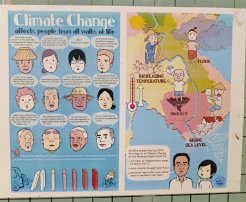 Adaptation to climate change includes
Adaptation to climate change includes  things like structural measures, migration, and mitigation. Some structural measures have to be taken in order for farmers to survive climate change. Examples of these measures include building gates and dikes, pumping stations, and water storage. If people living in the Mekong are unable to adapt to these changes, they will have to migrate to areas of higher land that will not be affected as harshly by SLR. One of the most important things people can do to attempt to combat climate change is mitigation. Mitigation in the Mekong can be accomplished by implementing water management to reduce green house gas emissions from rice fields.
things like structural measures, migration, and mitigation. Some structural measures have to be taken in order for farmers to survive climate change. Examples of these measures include building gates and dikes, pumping stations, and water storage. If people living in the Mekong are unable to adapt to these changes, they will have to migrate to areas of higher land that will not be affected as harshly by SLR. One of the most important things people can do to attempt to combat climate change is mitigation. Mitigation in the Mekong can be accomplished by implementing water management to reduce green house gas emissions from rice fields.
 Over the next 50 years the Mekong Delta
Over the next 50 years the Mekong Delta  will face many problems brought on by climate change. The farmers that make up 76% of the population here will be heavily affected and if they cannot adapt to the changing world around them they will be forced to leave. Climate change is a problem for everyone however. We must all do what we can to help lessen the effects of climate change. It is important for everyone to be environmentally conscious and help those who will be hit the hardest.
will face many problems brought on by climate change. The farmers that make up 76% of the population here will be heavily affected and if they cannot adapt to the changing world around them they will be forced to leave. Climate change is a problem for everyone however. We must all do what we can to help lessen the effects of climate change. It is important for everyone to be environmentally conscious and help those who will be hit the hardest.
The Culture In Agriculture
The Culture In Agriculture by Hailey Jorgensen
After driving though the country side and sitting on the banks of the bustling Song Can Tho river, it is clear that Vietnam is from a culture that has forever lived off the land. Modern culture has infiltrated the country side as well as driven the development of large industrialized cities such as Ho Chi Minh city, but a deep connection to the land is still visible in the eyes of most Vietnamese people. The people of Vietnam have faced so much hardship in their past that their culture developed under the constant strain to simply survive. They have lived off the land for centuries and still rely on agriculture as a major survival mechanism even if today, much of it is to survive economically in a global market.
 Vietnam’s growing economy is now primarily based in the industry sector which has grown more rapidly than anything else since opening the Vietnamese economy to the global market in the 1980s. Still, agriculture accounts for over 20% of GDP with 54% of the labor force working in agriculture and 70% of the population living in rural areas. To this major portion of the population, agriculture continues to be a way of life. The Mekong River Delta region is the most prime example of a continued wide spread reliance on agriculture.
Vietnam’s growing economy is now primarily based in the industry sector which has grown more rapidly than anything else since opening the Vietnamese economy to the global market in the 1980s. Still, agriculture accounts for over 20% of GDP with 54% of the labor force working in agriculture and 70% of the population living in rural areas. To this major portion of the population, agriculture continues to be a way of life. The Mekong River Delta region is the most prime example of a continued wide spread reliance on agriculture.
With its fertile soils, rainy season, and accessible water sources throughout the region, the Mekong River Delta has long been the perfect place for agriculture The middle of the Delta region, having some of the most fertile soil, can grow just about anything, but rice is the primary crop produced in the Delta and has obtained a high economic growth rate of 11.5% in recent years. Known as the rice basket of the country, the Mekong produces about 50% of the country’s rice crop and 90% of the total amount of rice used for export.
The skyrocketing growth in rice production in the Mekong River Delta has been driven by this strong desire for economic growth. 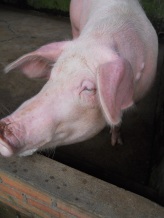 The issue with this economic growth is that the amount of land left to use is becoming depleted. Though the amount of available agricultural land in the Mekong is 2.6 million hectares, the amount of area cultivated each year is over 4 million hectares. How is this possible? In recent years, farmers have been increasing their yields by planting three to four crops a year, thus allowing them to plant more land area per year than is physically available. This form of intensive agriculture is forcing farmers to overuse chemical fertilizers and pesticides, which challenges the sustainability of the natural systems. This process has begun to cause numerous problems with pollution, biodiversity loss, and chemical dependence, and primarily, it is inhibiting the ability of the land to produce crops.
The issue with this economic growth is that the amount of land left to use is becoming depleted. Though the amount of available agricultural land in the Mekong is 2.6 million hectares, the amount of area cultivated each year is over 4 million hectares. How is this possible? In recent years, farmers have been increasing their yields by planting three to four crops a year, thus allowing them to plant more land area per year than is physically available. This form of intensive agriculture is forcing farmers to overuse chemical fertilizers and pesticides, which challenges the sustainability of the natural systems. This process has begun to cause numerous problems with pollution, biodiversity loss, and chemical dependence, and primarily, it is inhibiting the ability of the land to produce crops.
 This adoption of industrial chemical fertilizer, though not part of traditional farming practices, has become increasingly common in agricultural systems especially in areas where high demands are being placed. The people of Vietnam are only trying to keep up in a global economy to make a living and in the process they are irreversibly harming their land. It is because of this over-cultivation that environmentally sustainable agricultural practices are needed. It is because of this global market stress that these practices must be economically viable for the people.
This adoption of industrial chemical fertilizer, though not part of traditional farming practices, has become increasingly common in agricultural systems especially in areas where high demands are being placed. The people of Vietnam are only trying to keep up in a global economy to make a living and in the process they are irreversibly harming their land. It is because of this over-cultivation that environmentally sustainable agricultural practices are needed. It is because of this global market stress that these practices must be economically viable for the people.
 As many of our speakers have stressed, the people of this region do not have the luxury of being “green” simply because it is environmentally beneficial; they must receive economic benefits as well. There is no reason that a culture as vibrant as this should sacrifice their land simply for economic gain. Finding ways to sustainably cultivate crops such as rice would not only restore the land its self, but it would help restore the Vietnamese connection to a natural reliance on the land.
As many of our speakers have stressed, the people of this region do not have the luxury of being “green” simply because it is environmentally beneficial; they must receive economic benefits as well. There is no reason that a culture as vibrant as this should sacrifice their land simply for economic gain. Finding ways to sustainably cultivate crops such as rice would not only restore the land its self, but it would help restore the Vietnamese connection to a natural reliance on the land.
Do I Smell Pho?
Do I Smell Pho? By Ellen Brandell
Food: some people eat too much; others don’t eat enough. Food can be raw, broiled, baked, blackened, buried, boiled, dried, juiced, or pickled. No matter how it is prepared, food is an essential part of every culture. When it comes to food, the Vietnamese have perfected the art of preparation.
Imagine walking into an open restaurant where lanterns are lit, a pond sits near the entrance, and at every table families are enjoying a sit-down meal. 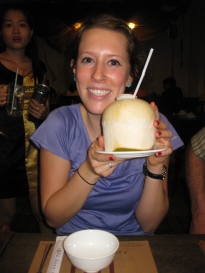 You are led through a maze of tables, up a set of stairs you didn’t know existed and sit down at a long table that accommodates 20. This describes our first group dinner in the country of Vietnam.
You are led through a maze of tables, up a set of stairs you didn’t know existed and sit down at a long table that accommodates 20. This describes our first group dinner in the country of Vietnam.  While I sipped on a fresh coconut, the waiter brought us dish upon dish of the house’s finest cuisine (since we trusted his judgment more than our own), and we dove in. All of the dishes are intended to be shared among the diners. The Vietnamese use mealtimes to sit down for hours, catch up, enjoy each other’s company, and yell countdowns for taking shots of rice wine. To my surprise, the dishes aren’t as spicy as I anticipated. The spicy sauces are served as side dishes so everyone can enjoy the food how they desire.
While I sipped on a fresh coconut, the waiter brought us dish upon dish of the house’s finest cuisine (since we trusted his judgment more than our own), and we dove in. All of the dishes are intended to be shared among the diners. The Vietnamese use mealtimes to sit down for hours, catch up, enjoy each other’s company, and yell countdowns for taking shots of rice wine. To my surprise, the dishes aren’t as spicy as I anticipated. The spicy sauces are served as side dishes so everyone can enjoy the food how they desire.
In addition to the delicious plates of rice, fresh fish, noodles with vegetables, savory ”pancakes”, spring rolls, and other restaurant delicacies, street food also plays an important role in Vietnamese culture.  While exploring the cities of Ho Chi Minh and Can Tho, we discovered that street food options seem limitless. My favorite is called boba, which is a milky tea with tapioca balls, but there is more substantial food as well: waffles, noodles, desserts, sandwiches, and the list goes on. The best part about street food in Vietnam is the killer price – sandwiches sold for 6.000 dong; about 30 cents! Looking for a quick fix of fried or handheld food? Hit the streets.
While exploring the cities of Ho Chi Minh and Can Tho, we discovered that street food options seem limitless. My favorite is called boba, which is a milky tea with tapioca balls, but there is more substantial food as well: waffles, noodles, desserts, sandwiches, and the list goes on. The best part about street food in Vietnam is the killer price – sandwiches sold for 6.000 dong; about 30 cents! Looking for a quick fix of fried or handheld food? Hit the streets.
 If you prefer to make your own meals, get up in the morning and walk the streets of Can Tho.
If you prefer to make your own meals, get up in the morning and walk the streets of Can Tho.  Our group was in awe of the market vendors’ stands piled high with the freshest fruits, vegetables, meats, and seafood available. The mangos taste like they were just picked this morning, which they probably were, and the smell of sun-dried shrimp lingers in the air. These markets, however, are not for the faint hearted; be prepared to see a fish’s head sliced off right in front of you!
Our group was in awe of the market vendors’ stands piled high with the freshest fruits, vegetables, meats, and seafood available. The mangos taste like they were just picked this morning, which they probably were, and the smell of sun-dried shrimp lingers in the air. These markets, however, are not for the faint hearted; be prepared to see a fish’s head sliced off right in front of you!
“So,” you say, “this sounds nice, but where’s the adventure?” Don’t worry! Soup is extremely popular in Vietnam,  the most popular being Pho. Pho, pronounced fa, hot pots, and other soups are made with the entire animal because bones and organs give the broth a more robust flavor. So far, our group has discovered, and tasted, chicken feet, liver, unidentifiable organs, and animal fat found in the soups.
the most popular being Pho. Pho, pronounced fa, hot pots, and other soups are made with the entire animal because bones and organs give the broth a more robust flavor. So far, our group has discovered, and tasted, chicken feet, liver, unidentifiable organs, and animal fat found in the soups.  If your adventure lies with spice, chilies are put on the side and don’t let their size deceive you; they will light your mouth on fire! At our first dinner, an item on the menu was “false dog”, which is perhaps not as exotic as real dog, but still unusual to Americans! Many times, our interpreters order for us, and we pass the food and along a simply try it all. We may have no idea what it is, but it ends up in our tummy and puts a smile on our face; I would say that in itself is an adventure.
If your adventure lies with spice, chilies are put on the side and don’t let their size deceive you; they will light your mouth on fire! At our first dinner, an item on the menu was “false dog”, which is perhaps not as exotic as real dog, but still unusual to Americans! Many times, our interpreters order for us, and we pass the food and along a simply try it all. We may have no idea what it is, but it ends up in our tummy and puts a smile on our face; I would say that in itself is an adventure.
 I hope you understand by now that Vietnam has any cuisine you might be craving, tons of foods that you have never seen before, and an endless list of delicious morsels. With a long coastline famous for its fishing industry, a background full of different influences, and a tropical climate for agriculture and native crops, it is no wonder that food in Vietnam is so delicious and so diverse. The moral of this story is to hop on a plane to Vietnam and have an empty stomach when you arrive!
I hope you understand by now that Vietnam has any cuisine you might be craving, tons of foods that you have never seen before, and an endless list of delicious morsels. With a long coastline famous for its fishing industry, a background full of different influences, and a tropical climate for agriculture and native crops, it is no wonder that food in Vietnam is so delicious and so diverse. The moral of this story is to hop on a plane to Vietnam and have an empty stomach when you arrive!
Trash In Vietnam: A Problem too Big to Sweep Under the Rug
“Trash In Vietnam: A Problem too Big to Sweep Under the Rug” by Rebecca Stone
 As I walk down the bank of Hậu River, To-go boxes float as freely as Water Hyacinths down the murky waters of this large tributary of the Mekong River. Trash has become an ever-increasing problem in most developing countries since the introduction of disposable containers made out of materials like Styrofoam and plastic. A combination of mass production, consumerism, globalization, and a touch of laziness has switched the attitude of the entire world away from reusable items that you can wash and reuse to ones which you can simply discard after you are done. Vietnam is no exception to this problem. The lack of funding for managing waste, along with a “out of hand-out of mind” mentality leaves a lot of trash unclaimed and left as a reminder of the great impact that humans can have on our environment.
As I walk down the bank of Hậu River, To-go boxes float as freely as Water Hyacinths down the murky waters of this large tributary of the Mekong River. Trash has become an ever-increasing problem in most developing countries since the introduction of disposable containers made out of materials like Styrofoam and plastic. A combination of mass production, consumerism, globalization, and a touch of laziness has switched the attitude of the entire world away from reusable items that you can wash and reuse to ones which you can simply discard after you are done. Vietnam is no exception to this problem. The lack of funding for managing waste, along with a “out of hand-out of mind” mentality leaves a lot of trash unclaimed and left as a reminder of the great impact that humans can have on our environment.
 As cognizant beings, humans have more power to help the world than any other life form on the planet, but we also have to power to destroy it. So many fail to realize that our day-to-day actions have an immense impact on the natural world around us. During my time in Vietnam so far, I have watched a man finish his lunch on the train and throw his entire Styrofoam container, plastic bag, empty water bottle and utensils out of the window. I have seen cows, monkeys, and stray dogs chewing on trash left by careless people. And just last night, I stopped a little girl from throwing her candy wrapper into the water after she had finished her treat.
As cognizant beings, humans have more power to help the world than any other life form on the planet, but we also have to power to destroy it. So many fail to realize that our day-to-day actions have an immense impact on the natural world around us. During my time in Vietnam so far, I have watched a man finish his lunch on the train and throw his entire Styrofoam container, plastic bag, empty water bottle and utensils out of the window. I have seen cows, monkeys, and stray dogs chewing on trash left by careless people. And just last night, I stopped a little girl from throwing her candy wrapper into the water after she had finished her treat.
 After talking with a student of Biotechnology at Can Tho University, it seems that it is simply engrained in the mindset of the Vietnamese people to discard their trash on the ground. “I was walking with my friend one day” she said, “and I had just finished my water and was looking for a trash can to throw my empty bottle in. I asked my friend if she knew where I could throw it away and she replied, “Oh yes, let me take care of it.” She grabbed the water bottle from my hands and tossed it over her shoulder into the street.” This student went on to explain to me that people may be educated about the right way to dispose of their waste, in school or otherwise, but it is very hard for people to make that connection between what one learns and their actions in life. As Americans we have had it hammered into our brains that littering is bad, but we still produce more trash per person than any other country: a staggering 2,076lbs a year.
After talking with a student of Biotechnology at Can Tho University, it seems that it is simply engrained in the mindset of the Vietnamese people to discard their trash on the ground. “I was walking with my friend one day” she said, “and I had just finished my water and was looking for a trash can to throw my empty bottle in. I asked my friend if she knew where I could throw it away and she replied, “Oh yes, let me take care of it.” She grabbed the water bottle from my hands and tossed it over her shoulder into the street.” This student went on to explain to me that people may be educated about the right way to dispose of their waste, in school or otherwise, but it is very hard for people to make that connection between what one learns and their actions in life. As Americans we have had it hammered into our brains that littering is bad, but we still produce more trash per person than any other country: a staggering 2,076lbs a year.
 Americans may know how to use a trashcan, but the Vietnamese have a mindset that has been engrained with recycling.
Americans may know how to use a trashcan, but the Vietnamese have a mindset that has been engrained with recycling.  While reducing may not be in the forefront of people’s minds, reuse definitely is. In rural areas, most wastes from agricultural cultivation are reused and either fed to livestock or used in compost and fertilizer. Reusable and recyclable wastes are also being separated by waste pickers, and then sold to the recycling business. In the capital city of Hanoi, waste pickers recycle approximately 20 percent of the municipal waste. In fact, while I was sitting in the park in Saigon drinking out of a big bottle of water, two women separately came up to me asking me if I was done with my bottle so that they could take it from me.
While reducing may not be in the forefront of people’s minds, reuse definitely is. In rural areas, most wastes from agricultural cultivation are reused and either fed to livestock or used in compost and fertilizer. Reusable and recyclable wastes are also being separated by waste pickers, and then sold to the recycling business. In the capital city of Hanoi, waste pickers recycle approximately 20 percent of the municipal waste. In fact, while I was sitting in the park in Saigon drinking out of a big bottle of water, two women separately came up to me asking me if I was done with my bottle so that they could take it from me.
 Apart from recycling, other “green” initiatives are starting to take place. In Ho Chi Minh City, foreign investors are undertaking several projects on landfill gas recovery for electricity generation. By reducing greenhouse gas emissions they are eligible to receive “carbon credits” under the Clean Development Mechanism of the UN Framework Convention of Climate Change. These credits can be sold in international markets, resulting in revenues for landfill operators.
Apart from recycling, other “green” initiatives are starting to take place. In Ho Chi Minh City, foreign investors are undertaking several projects on landfill gas recovery for electricity generation. By reducing greenhouse gas emissions they are eligible to receive “carbon credits” under the Clean Development Mechanism of the UN Framework Convention of Climate Change. These credits can be sold in international markets, resulting in revenues for landfill operators.
Vietnam is a country filled with beauty in its landscapes and its peoples, but the staggering amount of trash not only detracts from that beauty but poses severe environmental and health risks. Along with a need for increased government funding for municipal waste management, the government and mass organizations should encourage awareness of the trash problem in and out of the education system. Campaigns should highlight the importance of accountability for ones waste and promote the view that clean is beautiful and healthy for the people and the environment. This will be a great challenge in the coming years but paramount to the wellbeing and positive future of this beautiful place.
Green Montana Meets Green Vietnam: Exchanges Between University Student Environmental Groups
Green Montana Meets Green Vietnam: Exchanges Between University Student Environmental Groups by Sara Anderson
Many of the students on this trip participate in one or more environmental or social justice student groups trying to  spark various kinds of change on our campus, in Missoula, at the state level, nationally or even internationally. We employ a huge range of tactics and collaborate with a wide range of organizations working towards similar ends. For me personally, the scale of many of the problems we are working to address is so large
spark various kinds of change on our campus, in Missoula, at the state level, nationally or even internationally. We employ a huge range of tactics and collaborate with a wide range of organizations working towards similar ends. For me personally, the scale of many of the problems we are working to address is so large  that I am constantly looking to share ideas about how to proceed and to find evidence that my fellow group members and I are not the only people who care about the issue and are not the only ones working to address it. As a student, I am particularly interested in the thoughts and efforts of other students, especially those who, like me, participate in student groups with the purpose of addressing the environmental and social issues of our time.
that I am constantly looking to share ideas about how to proceed and to find evidence that my fellow group members and I are not the only people who care about the issue and are not the only ones working to address it. As a student, I am particularly interested in the thoughts and efforts of other students, especially those who, like me, participate in student groups with the purpose of addressing the environmental and social issues of our time.
With this in mind, I was anticipating meeting with the 350.org group at Nong Lam University in Ho Chi Minh City (http://www.350.org/en/node/27549). Dan had met with them the prior year and returned with a picture of about 20 group members in matching shirts. When we met the students at Nong Lam, though, only one was wearing the 350.org shirt.  One of the other students spoke about the environmental activities of the university, including the participation of 1000 students in Earth Hour (http://www.earthhour.org/), a waste recycling day in 2012 including teaching about the three ‘t’s (Tiết giảm – Tái sử dụng – Tái chế or Reduce – Reuse – Recycle), and planting trees in the mangrove preserve we visited, Can Gio.
One of the other students spoke about the environmental activities of the university, including the participation of 1000 students in Earth Hour (http://www.earthhour.org/), a waste recycling day in 2012 including teaching about the three ‘t’s (Tiết giảm – Tái sử dụng – Tái chế or Reduce – Reuse – Recycle), and planting trees in the mangrove preserve we visited, Can Gio.
After the formal presentations, we took a walk around the campus and I was able to chat with the lone 350.org shirt wearer. As it turned out, the group was no longer in existence because it had lost the university’s support and funding due to the presence of two other department (Environment and Forestry) sponsored environmental groups operating on the campus. I found this limitation to be particularly interesting given that it sometimes seems that our campus has an environmental or social action group for every student who cares to participate in one, each with a slightly different focus but all with the same general aim: creating and preserving a livable future.
She did say that the roles of the 350.org group were being performed by the other environmental groups. I didn’t ask if she had joined one of the other groups or how many students participate in the two groups or how the activities of the environmental groups were received by the other students.
 At Can Tho University we met with another group of students. The president of the environmental club, a business student, told us a bit about the work the club does. They were focused on cleaning up the campus and educating the students about the amount of trash on campus so they would take care of the land and not litter. The club was also working on a larger project to clean up trash from the river running through Can Tho.
At Can Tho University we met with another group of students. The president of the environmental club, a business student, told us a bit about the work the club does. They were focused on cleaning up the campus and educating the students about the amount of trash on campus so they would take care of the land and not litter. The club was also working on a larger project to clean up trash from the river running through Can Tho.
The most valuable conversation I had was with a biotechnology student who had a very thoughtful take on the effectiveness of the environmental club. She said it was a very small group, composed largely of students outside the environmental major who just cared about the environment.  She suggested the club should work to recruit members from the environment department in order to benefit from their greater knowledge from their studies as well as the greater degree of authority their membership would confer on the group. The participation of environmental studies students would also help gain further support from the university and possibly also more funds which would help them pursue bigger projects and recruit more members from diverse programs across the university and get the word out about their group and the work they are doing.
She suggested the club should work to recruit members from the environment department in order to benefit from their greater knowledge from their studies as well as the greater degree of authority their membership would confer on the group. The participation of environmental studies students would also help gain further support from the university and possibly also more funds which would help them pursue bigger projects and recruit more members from diverse programs across the university and get the word out about their group and the work they are doing.
 We also talked about the attitudes of people in Vietnam who didn’t participate in the environmental groups. She highlighted the importance of early education about environmental issues, telling me people who didn’t learn to be concerned about the environment in primary and secondary school weren’t going to suddenly develop an interest when they got to college. Here, as in the US, people have other concerns. The specific details of the environmental problems we face vary from place to place as do the cultures that shape peoples’ motivations, but we share one primary challenge: getting people involved.
We also talked about the attitudes of people in Vietnam who didn’t participate in the environmental groups. She highlighted the importance of early education about environmental issues, telling me people who didn’t learn to be concerned about the environment in primary and secondary school weren’t going to suddenly develop an interest when they got to college. Here, as in the US, people have other concerns. The specific details of the environmental problems we face vary from place to place as do the cultures that shape peoples’ motivations, but we share one primary challenge: getting people involved.
I know the students at both universities were excited to meet us and exchange ideas. The presenter at Nong Lam University thought our visit was so important that she wanted to be able to communicate directly with us and had carefully written out her whole speech in English so she would be able to say everything correctly. 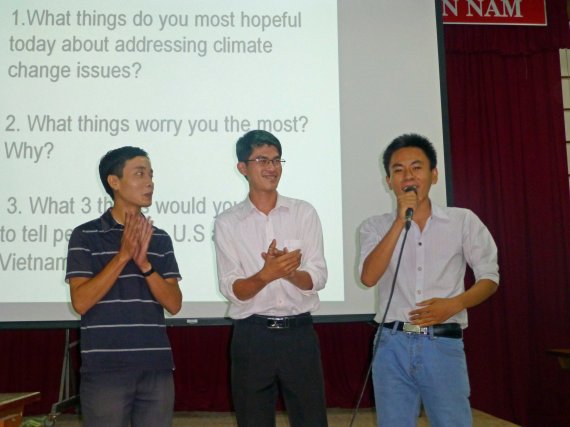 It makes me wonder what more we would have been able to share if we had more time together, either just a few more hours so we didn’t have to squeeze getting to know each other a bit and talking about the environment into the same short period of time or even a few weeks to establish a small amount of shared experience and have the potential for conversations to rise naturally out of that experience.
It makes me wonder what more we would have been able to share if we had more time together, either just a few more hours so we didn’t have to squeeze getting to know each other a bit and talking about the environment into the same short period of time or even a few weeks to establish a small amount of shared experience and have the potential for conversations to rise naturally out of that experience.
Agent Orange Lingers Decades After Vietnam War
Agent Orange Lingers Decades After Vietnam War by David Schaad
During our time together in Vietnam´s urban and rural environments, several of us have remarked to one another about how easy it seems as outsiders to forget that less than 40 years ago, this country was in the throes of a costly and brutal war. Vast, lush mangrove forests in particular, recently reborn from expansive war-borne wastelands, make the war seem like a distant dream.
 Still, the wounds and losses of war remain painfully vivid in many people´s lives today. In particular, the ongoing issues and concerns surrounding the use of chemical defoliants by the United States military are impossible to escape.
Still, the wounds and losses of war remain painfully vivid in many people´s lives today. In particular, the ongoing issues and concerns surrounding the use of chemical defoliants by the United States military are impossible to escape.
For a decade ending in 1971, U.S. military aircraft sprayed 72 million liters (20 million US gallons) of concentrated defoliants over thousands of square miles of forest and farmland – 16% of South Vietnam in total and nearly 19% of all of Vietnam´s forested terrain –  to erase the natural cover of Viet Cong forces. (The Viet Cong, also known as the National Liberation Front (NLF), sought to reunite South Vietnam with the North as a single unified nation under communist rule). This offensive would become the most concentrated effort to obliterate a nation´s natural ecology in the history of humankind.
to erase the natural cover of Viet Cong forces. (The Viet Cong, also known as the National Liberation Front (NLF), sought to reunite South Vietnam with the North as a single unified nation under communist rule). This offensive would become the most concentrated effort to obliterate a nation´s natural ecology in the history of humankind.
Agent Orange was only one of several defoliants used during this decade, four of which contained dioxin – but it was the most widely used and has therefore received the most attention. Many have deemed dioxin (actually 2-3-7-8 tetra chlorodibenzo-p-dioxin or TCDD) to be among the most deadly and harmful of all known substances known to humankind. A mere 85 grams of TCDD would be sufficient to kill a city of 8 million..
Many have deemed dioxin (actually 2-3-7-8 tetra chlorodibenzo-p-dioxin or TCDD) to be among the most deadly and harmful of all known substances known to humankind. A mere 85 grams of TCDD would be sufficient to kill a city of 8 million..
Japanese photographer Goro Nakamura cites that four million Vietnamese have been adversely affected by Agent Orange, though it is likely that this number does not account for more recent cases. Dioxins are persistent environmental toxins, meaning that they do not quickly disintegrate or disperse from sites sprayed during the war and can linger in sediments and soils, both on land and under water, for generations. Dioxins accumulate in fatty tissue and enter the food chain through the animals or fish that feed in affected areas; they also biomagnify up the food chain.
 Agent Orange residues in the soil which have remained long after the war have exposed many farmers and their families to TCDD unknowingly, and while many of these people have continued to appear healthy, they give birth to deformed, even stillborn children with mutated DNA. Those who live past birth may look as though they have leprosy, while others are troubled by mental disorders; deformed limbs, bodies or faces; congenital blindness;
Agent Orange residues in the soil which have remained long after the war have exposed many farmers and their families to TCDD unknowingly, and while many of these people have continued to appear healthy, they give birth to deformed, even stillborn children with mutated DNA. Those who live past birth may look as though they have leprosy, while others are troubled by mental disorders; deformed limbs, bodies or faces; congenital blindness;  Parkinson´s and heart diseases; or other conditions which either allow for a severely reduced life span or require constant care from family members, rendering these individuals vulnerable and disabled, and putting emotional and resource strains on their families.
Parkinson´s and heart diseases; or other conditions which either allow for a severely reduced life span or require constant care from family members, rendering these individuals vulnerable and disabled, and putting emotional and resource strains on their families.
Vietnamese victims have sued 37 chemical companies, most notably Dow Chemical and Monsanto, hoping to receive compensation for suffering birth defects, congenital diseases, 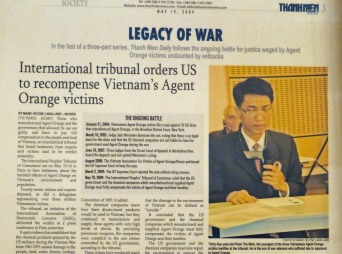 and aforementioned genotoxic (multi-generational) effects. The U.S. Supreme Court absolved the chemical companies of any such liability, although these companies did pay out a US$180 million sum to compromised U.S. soldiers who fought in Vietnam.
and aforementioned genotoxic (multi-generational) effects. The U.S. Supreme Court absolved the chemical companies of any such liability, although these companies did pay out a US$180 million sum to compromised U.S. soldiers who fought in Vietnam.
Recently, though highly overdue, an important first step was made towards permanent cleanup of residual TCPP in Vietnam. In June of 2012, the United States government finally committed to a dioxin removal project, which will extract dioxin from 71 acres of land at the airport in Danang, Vietnam, the previous site of a U.S. military base. The project will require four years to carry out and carries a price tag of $32 million. Other former U.S. air bases have been identified with alarming concentrations of dioxin, which continues to seep into the surrounding soil and neighboring waterways, but no further cleanup has yet been guaranteed by the United States.
A far more comprehensive and substantial effort will be required to repair damaged soils and waterways. A recent estimate by the Aspen Institute determined that the U.S. Government would need to spend nearly ten times the cost of this first project to eliminate the remaining toxic dioxin concentrations in  Vietnam and provide compensation to disabled Vietnamese.
Vietnam and provide compensation to disabled Vietnamese.  While families of retired U.S. soldiers receive up to US$1,500 per month in compensation for Agent Orange related health issues, Vietnamese families who are lucky enough to receive financial assistance take in a meager $5US in the same time period to support disabled children.
While families of retired U.S. soldiers receive up to US$1,500 per month in compensation for Agent Orange related health issues, Vietnamese families who are lucky enough to receive financial assistance take in a meager $5US in the same time period to support disabled children.
While we cannot undo the evils of the past, as U.S. citizens we still have a crucial role to play with regard to the cleanup of Agent Orange. Our government and our chemical companies brought this tragedy on the people and ecosystems of Vietnam, albeit before most of us were born. Bestowed with great privilege as Montanans and as Americans, blessed with healthy landscapes and political influence, we must put continued pressure on the Obama Administration to fund and support the bioremediation of this toxic chemical to the fullest extent possible.  We also ask that appropriate financial compensation and resources be given to the Vietnamese who lost so much and who are left to care for their disabled family members. This is what we owe the Vietnamese people as a strong and wealthy nation, as friends, and as fellow human beings. The pursuit of justice in the wake of the war demands that we restore affected lands to full health and empower the victims of Agent Orange to the fullest extent possible.
We also ask that appropriate financial compensation and resources be given to the Vietnamese who lost so much and who are left to care for their disabled family members. This is what we owe the Vietnamese people as a strong and wealthy nation, as friends, and as fellow human beings. The pursuit of justice in the wake of the war demands that we restore affected lands to full health and empower the victims of Agent Orange to the fullest extent possible.
~~~~~~~~~~~~~~~~~~~~~~~~~~~~~~~~~~~~~~~~~~~~~~~~~~~~~~~~~~~~~~~
INFORMATION SOURCES:
Lonely Planet Guidebook
War Remnants Museum, particularly:
“Agent Orange in the Vietnam War” by Goro Nakamura (panel at the War Remnants Museum, Ho Chi Minh City, Vietnam).
PLUS: WEBSITES:
http://www.who.int/mediacentre/factsheets/fs225/en/
http://makeagentorangehistory.org/about-agent-orange/agent-orange-dioxin/
Wikipedia: http://en.wikipedia.org/wiki/Agent_Orange
http://www.theasian.asia/archives/28149
http://www.huffingtonpost.com/2011/06/17/agent-orange-cleanup-vietnam-us_n_879116.html
http://www.independent.co.uk/news/world/asia/the-terrible-legacy-of-agent-orange-8034869.html
Paying Our Respects to Bac Ho’s City
The first four days of our program in Vietnam found us immersed in Ho Chi Minh City, known as Saigon prior to the triumph of the North in 1975 following three decades of the “French Indochina” and “American Wars.” Named after the founder of the Vietnamese Communist Party, Ho Chi Minh is beloved by many Vietnamese as “father of the nation” and referred to affectionately as Bac Ho, Uncle Ho.  Following our 30+ hour flights across the Pacific and a fourteen-hour time shift from Missoula, we wasted little time before starting our program with a two-hour briefing at the US Consulate in downtown HCMC. Economics officer Brian Neubert, Consular office Ted Diehl, and Public Affairs officer Thomas Tanner were very generous with their time and insights in helping us to understand the current context of U.S.-Vietnam relations: very positive in terms of bilateral trade and increased cooperation in security and military patterns, but more challenged in areas of human rights as the U.S. continues to have concern over the Vietnam Communist Party’s “narrative of control” expressed especially in the lack of freedom of the press and lengthy criminal sentences given to journalists perceived as threatening the security of the state. Vietnam, like China, continues to walk the tight-rope of a single party communist government embracing a full throttle market economy in what scholar Jonathan D. London terms “Market Leninism.”
Following our 30+ hour flights across the Pacific and a fourteen-hour time shift from Missoula, we wasted little time before starting our program with a two-hour briefing at the US Consulate in downtown HCMC. Economics officer Brian Neubert, Consular office Ted Diehl, and Public Affairs officer Thomas Tanner were very generous with their time and insights in helping us to understand the current context of U.S.-Vietnam relations: very positive in terms of bilateral trade and increased cooperation in security and military patterns, but more challenged in areas of human rights as the U.S. continues to have concern over the Vietnam Communist Party’s “narrative of control” expressed especially in the lack of freedom of the press and lengthy criminal sentences given to journalists perceived as threatening the security of the state. Vietnam, like China, continues to walk the tight-rope of a single party communist government embracing a full throttle market economy in what scholar Jonathan D. London terms “Market Leninism.”
The consulate briefing was very helpful in setting the historical context for our afternoon immersion in the War  Remnants Museum, that graphically portrays a Vietnamese perspective on the history of the “American War” and the extensive damage and suffering it inflicted on the Vietnamese people. The section on the effects of Agent Orange on both the civilian population and natural landscapes is particularly poignant and hard to absorb. According to Wikipedia, “between 1962 and 1971, the United States military sprayed nearly 20,000,000 US gallons (76,000,000 l) of material containing chemical herbicides and defoliants mixed with jet fuel in Vietnam, eastern Laos and parts of Cambodia, as part of Operation Ranch Hand. The program’s goal was to defoliate forested and rural land, depriving guerrillas of cover; another goal was to induce forced draft urbanization, destroying the ability of peasants to support themselves in the countryside, and forcing them to flee to the U.S. dominated cities, thus depriving the guerrillas of their rural support and food supply… Vietnam estimates 400,000 people were killed or maimed, and 500,000 children born with birth defects as a result of its use. The Red Cross of Vietnam estimates that up to 1 million people are disabled or have health problems due to Agent Orange.“ [See the next blog entry by David Schaad for a follow-up on the ongoing effects of Agent Orange in Vietnam.]
Remnants Museum, that graphically portrays a Vietnamese perspective on the history of the “American War” and the extensive damage and suffering it inflicted on the Vietnamese people. The section on the effects of Agent Orange on both the civilian population and natural landscapes is particularly poignant and hard to absorb. According to Wikipedia, “between 1962 and 1971, the United States military sprayed nearly 20,000,000 US gallons (76,000,000 l) of material containing chemical herbicides and defoliants mixed with jet fuel in Vietnam, eastern Laos and parts of Cambodia, as part of Operation Ranch Hand. The program’s goal was to defoliate forested and rural land, depriving guerrillas of cover; another goal was to induce forced draft urbanization, destroying the ability of peasants to support themselves in the countryside, and forcing them to flee to the U.S. dominated cities, thus depriving the guerrillas of their rural support and food supply… Vietnam estimates 400,000 people were killed or maimed, and 500,000 children born with birth defects as a result of its use. The Red Cross of Vietnam estimates that up to 1 million people are disabled or have health problems due to Agent Orange.“ [See the next blog entry by David Schaad for a follow-up on the ongoing effects of Agent Orange in Vietnam.]
The terrible legacy of the war on both Vietnam’s civilian population and natural ecosystems has made all the more poignant the warm hospitality we have received from everyone we have met.  Saturday afternoon took us to Nong Lam University to meet with students and faculty involved in climate change and environmental issues through the student 350 Vietnam club [see blog entry to follow by Sara Anderson for more on student environmental groups in Vietnam]. Driving under a banner that welcomed the delegation from the University of Montana, the warmth an excitement among our Vietnamese hosts was palpable as we got off the bus and entered the conference room. One shy student said she had not been able to sleep the night before she was so excited by our visit.
Saturday afternoon took us to Nong Lam University to meet with students and faculty involved in climate change and environmental issues through the student 350 Vietnam club [see blog entry to follow by Sara Anderson for more on student environmental groups in Vietnam]. Driving under a banner that welcomed the delegation from the University of Montana, the warmth an excitement among our Vietnamese hosts was palpable as we got off the bus and entered the conference room. One shy student said she had not been able to sleep the night before she was so excited by our visit.
A highlight of the visit was a talk by Dang Thao Huong on her master’s research on the potential for sustainable use native bamboo as a biofuel in order to protect native bamboo forests and habitat from further deforestation. Huong visited the University of Montana a few summers back on a State Department sponsored  exchange and is wild about Montana; she was our primary host during our days in Ho Chi Minh City, and in addition to presenting her research, she arranged for us to participate in a traditional Vietnamese tea ceremony, a traditional water puppet show, a visit to a Buddhist pagoda, and celebrating New Year’s Eve last night in downtown Ho Chi Minh City.
exchange and is wild about Montana; she was our primary host during our days in Ho Chi Minh City, and in addition to presenting her research, she arranged for us to participate in a traditional Vietnamese tea ceremony, a traditional water puppet show, a visit to a Buddhist pagoda, and celebrating New Year’s Eve last night in downtown Ho Chi Minh City.
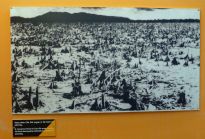 On Sunday we took a break from the intense energy of Ho Chi Minh City and
On Sunday we took a break from the intense energy of Ho Chi Minh City and 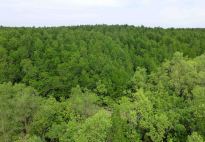 drove two hours east to the Can Gio Mangrove Nature Reserve. We were fortunate to be hosted by Dr. Nguyen Van Be of Can Tho University who is an expert on mangrove forest ecology and has been working in Can Gio since 1985. Can Gio was nearly completely deforested by Agent Orange during the Vietnam War; it was a sign of hope to see how much it has recovered through intensive restoration and conservation projects now spanning several decades.
drove two hours east to the Can Gio Mangrove Nature Reserve. We were fortunate to be hosted by Dr. Nguyen Van Be of Can Tho University who is an expert on mangrove forest ecology and has been working in Can Gio since 1985. Can Gio was nearly completely deforested by Agent Orange during the Vietnam War; it was a sign of hope to see how much it has recovered through intensive restoration and conservation projects now spanning several decades.
Two highlights of our visit were visiting a family sustainable shrimp farm and being hosted by them for a traditional rural Vietnamese meal, and then helping to plant mangroves as part of the ongoing restoration work in the reserve. 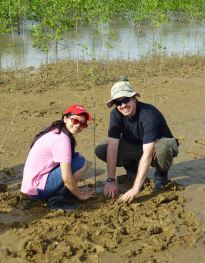 [For more on shrimp farming and aquaculture, see the entry by Rennie Winkelman later in the course. For more on mangrove ecology and restoration, see the entry by Aimee KellyDickinson next week. For more on issues of wildlife and biodiversity in Vietnam, see the upcoming entry by Milo Anderson.]
[For more on shrimp farming and aquaculture, see the entry by Rennie Winkelman later in the course. For more on mangrove ecology and restoration, see the entry by Aimee KellyDickinson next week. For more on issues of wildlife and biodiversity in Vietnam, see the upcoming entry by Milo Anderson.]
Our time in Ho Chi Minh City culminated on New Year’s Eve when we joined hundreds of thousands of Vietnamese citizens to ring in the new year – half of them, at least, cruising the downtown in an endless stream of motorbikes  that defies the imagination of how they can negotiate the traffic and pedestrians with virtually no accidents.
that defies the imagination of how they can negotiate the traffic and pedestrians with virtually no accidents. 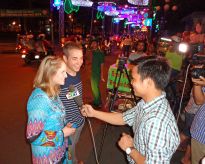 Ben Simonson and Harper Kaufman were picked out for interviews by Vietnam TV, which added to the fun. The joy and exuberance throughout the downtown seemed in many ways to exemplify the dynamic and entrepreneurial spirit for which Saigon and the southern Vietnamese long have been known. [For more on social relations in Vietnam, see the upcoming entry by Ben Simonson.]
Ben Simonson and Harper Kaufman were picked out for interviews by Vietnam TV, which added to the fun. The joy and exuberance throughout the downtown seemed in many ways to exemplify the dynamic and entrepreneurial spirit for which Saigon and the southern Vietnamese long have been known. [For more on social relations in Vietnam, see the upcoming entry by Ben Simonson.]
And now we have left Ho Chi Minh City for the quieter environs of Can Tho City and province. On New Year’s Day we drove through miles of lush green rice fields and endless canals of the Mekong Delta to reach this Delta hub; tomorrow we begin our formal program focusing on Climate Change in the Mekong Delta with our hosts at Can Tho University.  Check out this blog for additional entries by Hailey Jorgenson on Agriculture in the Mekong Delta, Ellen Brandell on Food in Vietnam, Rebecca Singleton on Responding to Climate Change and Madison Matthews on Climate Change Education; Michelle Harkins on the famous floating markets of Can Tho, Milan Vinks on water rights and management, Harper Kaufman on the place of Buddhism in Vietnam, Ada Montague on ecotourism and possibilities for fly fishing, and Justin Harkins on Vietnam’s National Parks. We are excited by what we have learned so far and energized to dig in further in our remaining time here. Please join us in this adventure!
Check out this blog for additional entries by Hailey Jorgenson on Agriculture in the Mekong Delta, Ellen Brandell on Food in Vietnam, Rebecca Singleton on Responding to Climate Change and Madison Matthews on Climate Change Education; Michelle Harkins on the famous floating markets of Can Tho, Milan Vinks on water rights and management, Harper Kaufman on the place of Buddhism in Vietnam, Ada Montague on ecotourism and possibilities for fly fishing, and Justin Harkins on Vietnam’s National Parks. We are excited by what we have learned so far and energized to dig in further in our remaining time here. Please join us in this adventure!



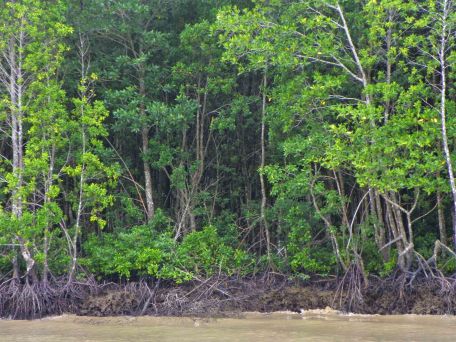














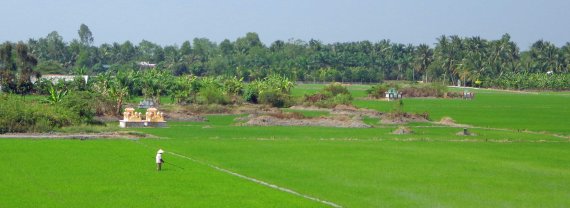




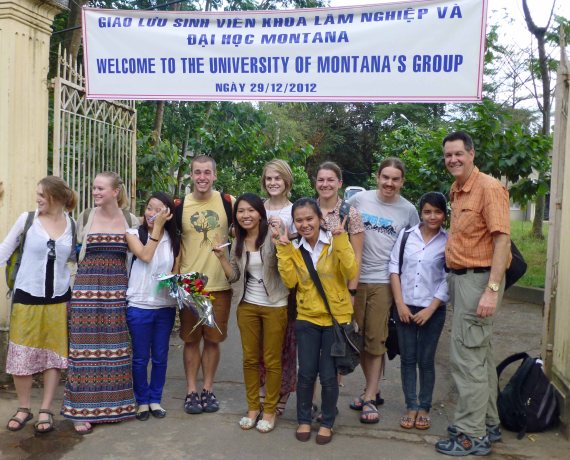

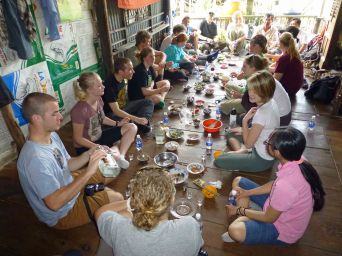
You must be logged in to post a comment.